#interesting periods of recent music history
Explore tagged Tumblr posts
Text
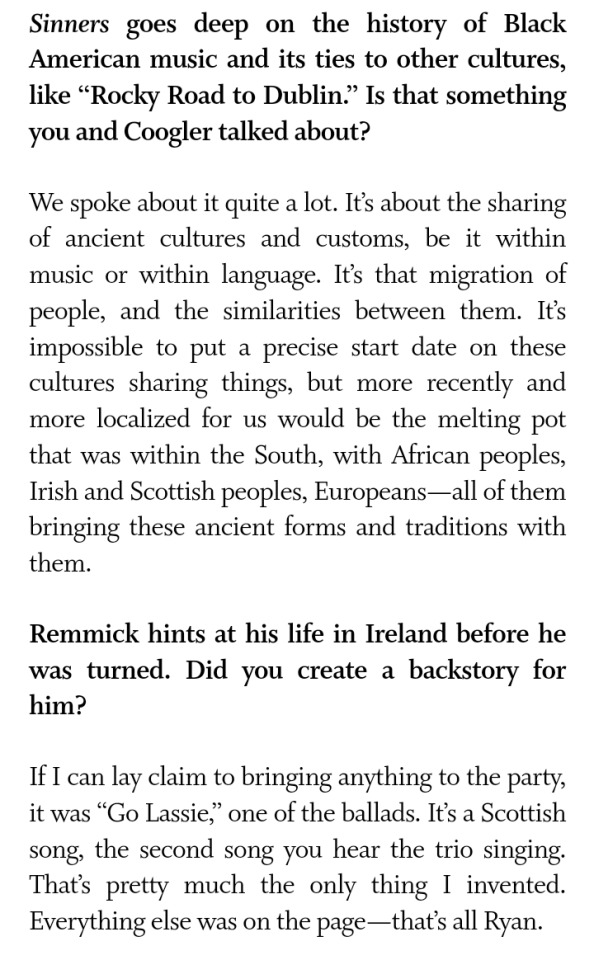
Shout out 🍻 🏴🤝🇮🇪
Will ye go, lassie, go?/Wild Mountain Thyme/Purple Heather/The Braes of Balquhidder - Robert Tannahill/Francis McPeake/Robert Archibald Smith
With Scots language subtitles - https://youtu.be/U4amVK3NL3w?
Full article below
Sinners Star Jack O’Connell on Playing an Irish-Dancing Vampire in Ryan Coogler’s Hit Film
“We just threw it down and started jigging.”
by Claire Valentine McCartney April 29, 2025

Spoilers ahead for Sinners.
For the first hour of Sinners, the Southern Gothic blockbuster from Black Panther director Ryan Coogler, you’d be forgiven for forgetting that the Michael B. Jordan-starring film is billed as a horror-action flick. Coogler dedicates such care to building the intricate world of the first half of the story (which is set over one 24-hour period in 1932 Mississippi) that when Jack O’Connell’s Irish vampire, Remmick, first appears onscreen—his bare skin smoking and peeling as a group of Native Americans chase him away—it’s a jolt. When he shows up a second time, politely asking to join a party at the Jordan-played twins’ freshly opened juke joint, it’s a marker that the film’s genre and tone are about to shift. And indeed, all hell breaks loose into a cataclysmic bloodbath.
O’Connell, 34, has been a cult-favorite actor since his days on beloved U.K. teen drama Skins. In Sinners, he plays the grinning Remmick with a charismatic edge. Although his character is a ravenous vampire seeking to turn the entire town into fellow undead (and steal their memories, talents, and music in the process), in the context of the viciously racist Jim Crow world the film is set in, where the Klu Klux Klan still runs free and violence waits in the shadows—Remmick offers a false but alluring post-racial utopia to his would-be prey. As an Irishman turned into a vampire before he arrived in America, Remmick seems to view race from the viewpoint of a disenfranchised outsider, rather than in the literal black-and-white terms the characters are otherwise boxed into. It’s an interesting dynamic that O’Connell says was already “all on the page” when he first received the Sinners script.
“Instantly, you could tell that Remmick was very well-written, with a lot of depth,” he tells W. “When you’re offered that, it’s a great starting point.” British-born with an Irish father, O’Connell was uniquely prepared for the role, which includes a climactic Irish step dance to the classic 19th-century folk song “Rocky Road to Dublin.” Below, O’Connell talks working with Coogler, getting back into his step dancing groove, and the next horror roles he already has lined up:
How does the huge reception to Sinners feel? It’s the number-one movie in America right now.
It’s massively rewarding to think that it’s gone down how we’d hoped. You just never know. Ryan Coogler is just a fucking brilliant filmmaker, so I’m just buzzing for everyone—but mainly for Ryan.
What did you think when you first read the script?
Obviously, I wanted to know about “Rocky Road to Dublin” and what that was doing within this piece. I wanted to know about the Irish dance, and I was massively surprised to find out that Ryan was going to try and do the genuine, traditional Irish stuff. He caught me off guard. But once I knew that he was down for the real deal, I thought, “Count me in.” It suddenly made sense.

Sinners goes deep on the history of Black American music and its ties to other cultures, like “Rocky Road to Dublin.” Is that something you and Coogler talked about?
We spoke about it quite a lot. It’s about the sharing of ancient cultures and customs, be it within music or within language. It’s that migration of people, and the similarities between them. It’s impossible to put a precise start date on these cultures sharing things, but more recently and more localized for us would be the melting pot that was within the South, with African peoples, Irish and Scottish peoples, Europeans—all of them bringing these ancient forms and traditions with them.
Remmick hints at his life in Ireland before he was turned. Did you create a backstory for him?
If I can lay claim to bringing anything to the party, it was “Go Lassie,” one of the ballads. It’s a Scottish song, the second song you hear the trio singing. That’s pretty much the only thing I invented. Everything else was on the page—that’s all Ryan.
How did you prepare for the big Irish dance scene in the middle of the film?
The dance was one of the first things I started preparing, mainly out of nerves and fear of getting it wrong. I used to do [Irish dance] as a kid, but that was nearly 30 years ago, so it felt a little out of my comfort zone. I teamed up with Angela O’Connor with the Academy of Irish Dance in London. We rented a space and just threw it down and started jigging. It was cool, man. She also choreographed something for that dance scene, and the timing of “Rocky Road to Dublin” is quite uncommon, the way the tempo is structured. So she had to wrap her head around that.
What was that day like on set?
It was a really transcendental experience. We’d done the outdoor section of that amazing one-shot journey through music, starting with Sammie’s song. Then the second half of the night, we got to “Rocky Road.” It was crazy. Everyone had their makeup and attire on, and the music was playing, and everyone was happy, and there was a real, eminent joy we felt. And then the sun came up, and we all had to stop, just like our vampires. We all had to go home and get some rest. It was really mind-blowing, life imitating art.
You had to wear quite a lot of prosthetics. Did that help you get into character?
Yes—the application of them can be a bit trying, with the contact lenses, and stuff going in and out of your mouth, things attached to your fingers. But once you surrender to it, things reveal themselves to you. Details make themselves apparent, and it can really help the character evolve.
There’s a lot of symbolism in the film, and Remmick’s character seems like a pretty clear metaphor for cultural appropriation and exploitation. What did you make of what he symbolizes, and did that affect how you played the character?
I’m probably going to take Ryan’s lead and just kind of agree that any metaphor within the story is in the eye of the beholder. As an actor and an artist, I’m always looking for hidden meanings and intellectual answers, so that’s not to say that they’re not deliberately put there. I definitely had my takes. But they’re so open to interpretation, and I respect Ryan for not really wanting to be too explicit about it.
You have the horror films 28 Years Later and its sequel, 28 Years Later: The Bone Temple coming up next. What makes you drawn to this genre?
It’s zombies, rage, apocalypse—we’ve got it all in there. But the genre is just coincidental. Filmmakersare what draw me. To go from Ryan Coogler’s set straight to Danny Boyle, I was just pinching myself. And then onto the Nia DaCosta set [for the sequel], it was a dream come true.
#quotes#scotland#ireland#scottish#irish#sinners#sinners spoilers#jack o'connell#interview#ryan coogler#nia dacosta#28 years later#film#folk music#celtic#scots irish#robert tannahill#francis mcpeake#robert archibald smith#poetry#scots language#language
97 notes
·
View notes
Text


Heading into mid-Tang, this is when the makeup, hair, and fashion starts becoming more and more exaggerated. We can also see hints of styles in later dynasties, for example the long robe found at Famen Temple that is similar to the style of the Song Dynasty.
(Not Hanfu related, but I recently started lessons at a Guqin school learning how to play and make this ancient instrument. If you're familiar with some Chinese period dramas, you might know this instrument, if not, the Guqin has a long history dating back to at least the Warring States period about 2500 years ago, possibly longer. It's slender in appearance, with 7 strings along the surface (originally 5 strings) that are plucked to create music.
In any case, if people are interested I'll throw in some posts about Guqin and my experience at the school, if not I'll keep this blog focused on Hanfu. Let me know :D)
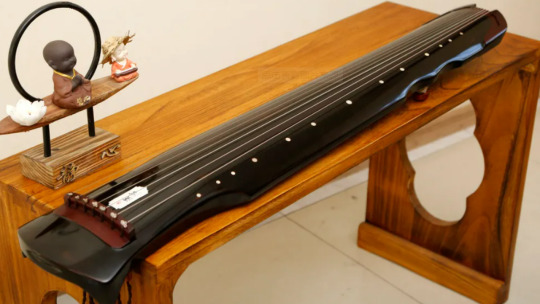




#hanfu#汉服#china#中国#chinese hanfu#culture#history#fashion#clothing#historical clothing#guqin#古琴#tang dynasty#唐朝#中唐#mid-tang
181 notes
·
View notes
Text
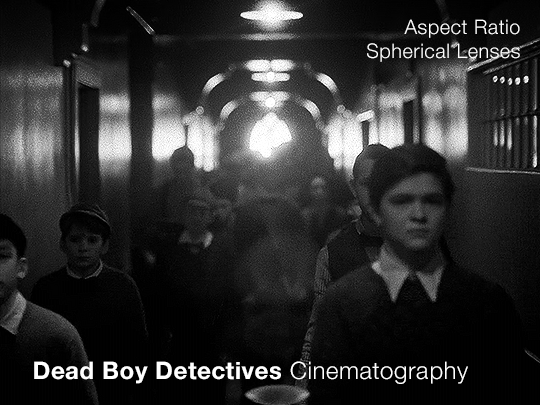
Part 2 — this time with a focus on the flashbacks
(Check out the first post for some background info that will be useful)
When we’re looking at the cinematography of any piece, once we’ve established what the norm is (which is the use of anamorphic lenses, as per the last post) we can then look to see where it diverges. As far as I can tell, the only part of Dead Boy Detectives that doesn’t use an anamorphic lens is Edwin’s flashback scene.
Now this is particularly interesting since not only is it filmed with a spherical lens, but it also is the only scene with a different aspect ratio, and the only scene in black and white. Everything about this scene is glaringly different. The easy and obvious reason is that it sets this scene apart as something important to pay attention to, as well as emphasizing the difference in the time period. But I want to highlight how exactly it does this since it is quite clever.
It also raises the question: Why not film Charles’ flashback scenes differently?
Like last time, let’s start with a review of history and technical information.
What is an aspect ratio?
This is just the ratio of the width to height of the frame. 1:1 is a square, whereas 2:1 is a rectangle twice as wide as it is high. In film, aspect ratios are usually listed as a ratio of x:1, so you get common formats like 1.85:1 and 2.39:1 (the second being a super-widescreen format, i.e. a long rectangle). Other common ratios are listed with different numbers, like 4:3 and 16:9. Any time I write an aspect ratio with other numbers, I’ll also list it at least once with the x:1 format so you can compare things easily.
What are some common aspect ratios and what have the standards been across the past 100+ years of film and television history?
Brief history of aspect ratios in Film
The original silent films were mostly filmed in 4:3 (1.33:1). This aspect ratio persisted until the late 20s/early 30s when the Academy Ratio, 1.375:1, was introduced and somewhat standardized (at least in the USA) until the 50s. Then, widescreen became pretty popular and was used to draw audiences to the theaters. At this point, we get tons of variation in aspect ratios in films. But, for American theaters, common projections are 1.85:1 (which became super common) and 2.40:1 or 2.39:1, whereas in some European theaters, 1.66:1 is a more common ratio.
Some other common ratios deal particularly with 70mm film:
Standard 70mm film is usually 2.2:1. However, using anamorphic lenses will create a higher aspect ratio, and unless using a specific format common in the 50s and 60s (Todd-AO), this wasn’t often the aspect ratio that viewers would see. (The Sound of Music was shot with Todd-AO in 2.2:1, but until recently, most people only saw the general release in 35mm, which had a different aspect ratio)
IMAX, which is 1.43:1 (if IMAX is shot on film and not digital, it uses 70mm film)
Brief history of aspect ratios in Television
Pretty much all televisions until around the 1990s-2000s used 4:3, and broadcasters would show content in that aspect ratio. If a movie was broadcast over TV, sometimes there would be letterboxing (black bars), but pan-and-scan was common, where they would crop the movie to the 4:3 ratio, and pan around to wherever the action was happening. Starting in the 90s, widescreen televisions started to gain traction, and the 16:9 (1.77:1) format prevailed, and TV broadcasting had some more wiggle room for aspect ratio.
**Side note: Computers are often at this ratio, so if you watch older TV shows on your laptop, you’ll probably see pillarboxing (black columns on the sides), whereas newer movies are often shot with higher aspect ratios so they have letterboxing (black bars on the top and bottom)**
A note on widescreen
Movies are usually considered widescreen if they’re any higher than 4:3 (or 1.33:1). However, because of the aspect ratio of modern TVs and computers, and the even higher aspect ratios of most smartphones in landscape mode, a lot of people (especially younger generations) won’t consider things “widescreen” until they’ve got a much higher aspect ratio.
Streaming and Aspect Ratios
A weird effect of streaming services, and in particular Netflix, was the rise of a new standard in aspect ratios, 2:1. It’s used in shows like Stranger Things. It’s widescreen enough that it feels cinematic but it displays well on lots of devices. There’s minimal letterboxing (or none) on your phone, and more letterboxing on your computer and TV, but not enough to seem like you’re watching a movie instead of a show.
Netflix (and Amazon) really like this aspect ratio. In 2017, one of the production requirement documents from Netflix stated that any aspect ratio greater than 2:1 had to be subject to further approval (though now they state “Aspect ratio choices should be discussed with Netflix for approval”). It’s become increasingly common, and these companies have a pretty set standard for 1.9:1 and 2:1. If we see those ratios on a streaming show it isn’t always a creative choice, similar to the way older TV shows were required to be in 4:3.
A brief reminder about lens types with some extra bits about the timeline.
That 2.39:1 aspect ratio that movies use? That’s the standard for anamorphic lenses (discussed in Part 1). Anamorphic technology was developed around 1915 (for military reasons), but wasn’t used for films until 1927, and didn’t become commonly used until the 50s.
So, with that, let’s look at Dead Boy Detectives.
Aspect Ratio
The whole show is shot with anamorphic lenses, but instead of a 2.39:1 ratio, they use a 2.2:1 ratio. This is a really interesting choice since it is an uncommon ratio. It’s more widescreen than Netflix shows (they started shooting before being acquired by Netflix though so we can ignore any impact Netflix may have had on this decision) but not quite the widescreen that anamorphic lenses typically use.
Movies and shows can use almost any aspect ratio today, but it is still common to stick to the standards. When they choose something else, it’s not because of technical limitations, but because of a creative choice.
The one caveat I have is that Doom Patrol used 2.2:1, so it’s possible that HBO and DC originally just chose this for continuity between the two, before the show was shifted over to Netflix and the Sandman universe. But for this post, I’m going to assume that they were sort of starting from scratch when choosing the look.
If we consider what a 2.2:1 ratio has been used for, and what viewers have been “trained” to associate it with, we end up with Todd-AO 70mm prints and a few others from the 50s and 60s. It’s the kind of aspect ratio you don’t see often unless you’re lucky enough to live near a theater with a 70mm film projector. There are a few notable movies shot in this aspect ratio: Lawrence of Arabia and 2001: A Space Odyssey. Some more recent movies that used 2.2:1 include Dunkirk, Tomorrowland, Nope, and the non-IMAX parts of Oppenheimer. It’s also occasionally used in recent TV, but not a ton, and not with many popular shows.
This is an aspect ratio used by large-format, high-budget movies. As mentioned in the previous post, anamorphic lenses are associated with a romanticized notion of “cinema” and this aspect ratio only serves to further that, associating Dead Boy Detectives with the limited pool of content made in this aspect ratio. It may be a TV show, but it’s being shot like a movie.
Another really interesting point that follows up on the previous post is the idea of using cinematography to enhance the sense of the supernatural and separate the characters from the normalcy of the real world. The aspect ratio is a bit unnatural too, which serves to complement and augment this.
Let’s briefly look at what the show would look like in different aspect ratios. As a baseline, this is the 2.2:1 aspect ratio that the show is in:
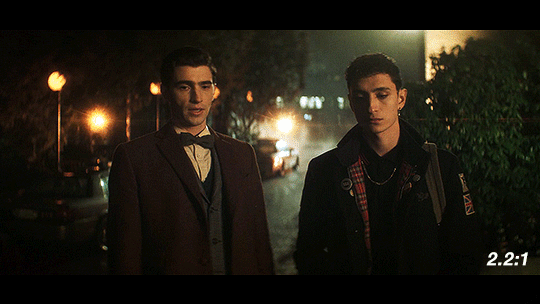
If they had gone for a 2.39:1, a very typical aspect ratio for the kind of lenses they’re using, it would look like this:
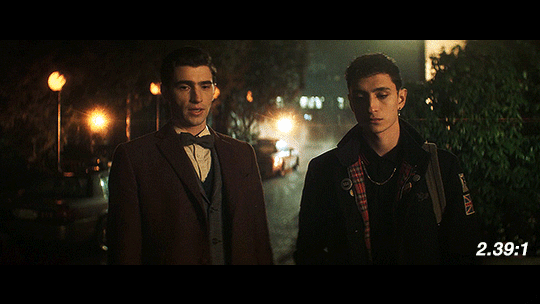
When we see things shot with anamorphic lenses, we’re used to seeing it in a frame like this one. Especially in shots like this with the dramatic lens flares, this is going to look and feel familiar to people who watch a lot of movies. It has more of that Star Trek (2009) look, and feels kind of glossy and polished.
Next up, we have 2:1, the aspect ratio popularized by Netflix. It’s a reasonable possibility that if this show had been produced by Netflix from the very beginning, this is what it would look like.
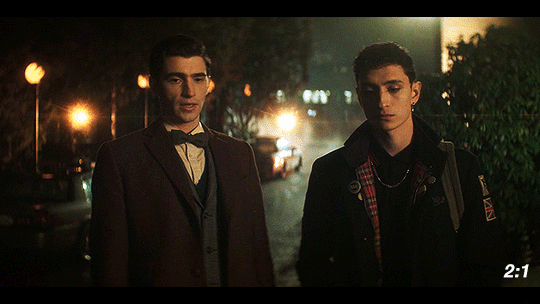
Over the past few years, this has become the “streaming platform” aspect ratio. With the extra vertical height, it’s got some extra space to breathe. We would get less of the background and more of the characters, especially since Dead Boy Detectives favors centered shots of single characters over group shots like this one.
Finally, I’ve got the scene in 1.85:1, a ubiquitous film aspect ratio, yet one that is not used often on TV.
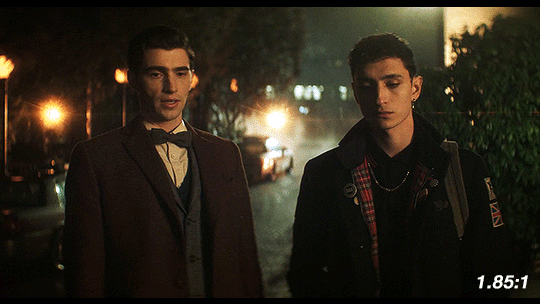
This is considered to be standard widescreen and it’s a great aspect ratio. Given how many creative decisions in this show were made to emphasize the supernatural, this could have been another good option as an aspect ratio, since we’re not used to seeing TV shows like this. However, they’re using anamorphic lenses so this would have required a lot of cropping. Because of how the anamorphic lenses work, this would also necessitate a lot of additional attention during the shoot. If they had gone with 1.85:1, we likely would have gotten a show shot on sphericals instead.
So what about Edwin’s flashback?
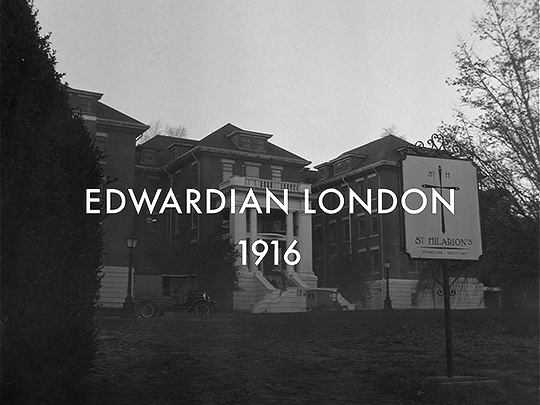
This section is shot in 4:3 (1.33:1). It’s the only part shot in a different aspect ratio. Sure, changing the aspect ratio forces us to acknowledge the difference in time period, but why exactly does it work so well?
Remember the history part? 4:3 was used for most of the early silent films. If we are to consider the “historical accuracy” of shooting the different time periods in this show, anamorphic lenses and 2.2:1 make sense for the present-day parts and Charles’ flashback.
But in 1916, widescreen cinema wasn’t a thing. If Edwin had ever been to see a movie while alive, it would have been in 4:3. The first time he would have ever gotten to see something in widescreen (if we assume he watches any movies at all) would be after he escaped Hell.
Using this aspect ratio is not just a vague decision that a lower aspect ratio and black & white looks older. It is, like many other aspects of the show, historically informed. They could have used the academy ratio here, but they didn’t. They used 4:3.
Not only does the aspect ratio switch for this scene, but also the height of the image changes.
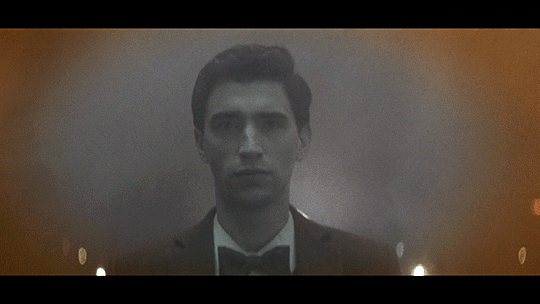
This transition also sort of mimics the breathing effect of anamorphic lenses:
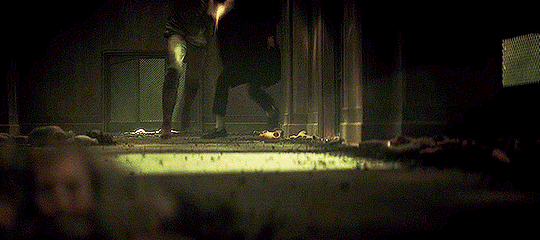
Something you may not know about how Netflix usually works is that regardless of the aspect ratio of the picture, the video file you see is part of a larger container, which is usually 16:9 (1.77:1). The black bars on top and bottom are part of the file, as shown in this screenshot of how it looks when you load up some screencaps in photoshop.
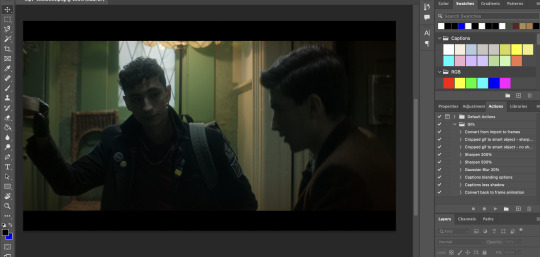
If you make gifs, edits, or are otherwise just used to having video files you are probably familiar with this. The Dead Boy Detectives files have letterboxing that is cropped out whenever people make fan content with it, whereas if you have a file for an independent movie, it usually does not have those black bars. Those black bars being part of the file make this transition possible.
We don’t usually realize that the container extends beyond the picture. For all we know, that’s the edge of the frame. But then it changes and forces us to reconsider what we previously thought to be true. Breaking out of what we think to be the image height is jarring, especially considering that this is the only time it happens (other than the brief flashbacks to the same footage later in the show).
Here’s a mockup of what it would look like if they kept the same image height, and just moved from 2.2:1 to 4:3 without expanding vertically. I find that it doesn’t have quite the same effect.
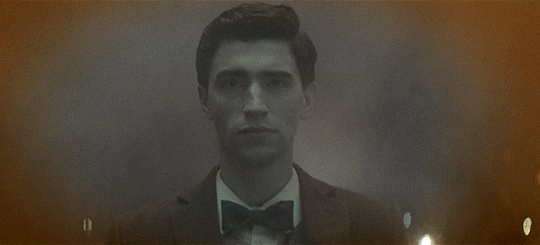
This would look so cool if it was being shown at a movie theater on a huge widescreen, but we’re not watching this show in theaters. We’re watching it on screens where this would make it look small; what they do instead retains the feel of watching something big and cinematic.
So back to the actual transition:

In breaking out of the perceived container, it’s as if it were breaking the fourth wall, an acknowledgment of the video’s format and its true container. This story is addressed to the audience in a way that the rest of the show is not, and it uses the aspect ratio to let us know that.
Spherical Lens
(I would highly recommend you read pt 1 if you haven’t already)
Edwin’s flashback is not only the sole scene with its own aspect ratio, it’s also the only scene shot with a spherical lens. Like the aspect ratio, this is a historically informed choice. Anamorphic lenses technically existed during the last year or two of Edwin’s life, but movies were not being shot on them.
How do we know that a spherical lens is being used, and how does this affect the show?
One of the quickest ways to identify the lens is to look at the shapes of the bokeh. There’s not much bokeh in the flashback, so I apologize for the intensity of my first example. But here, look behind Edwin’s head, where the lights from above reflect on the wet basement floor. They’re all circles, instead of the ovals that we get with the anamorphics.
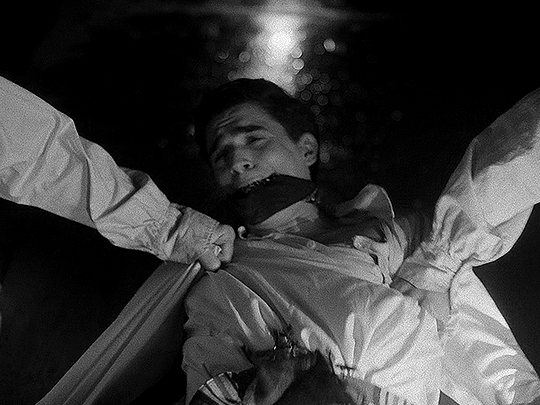
The lens flares are also really different. Remember that the anamorphic lens flares are horizontal lines. Spherical lenses don’t do that, but they can produce lots of different kinds of lens flares. In this shot, the flashlight pointed at the lens lets off lines in lots of directions, kind of like sun rays.
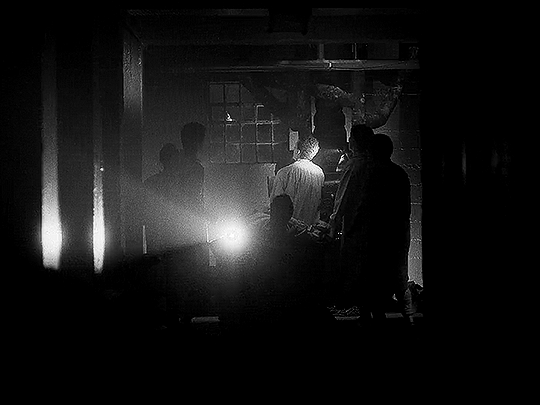
This shot has another cool flare, in much more detail this time:
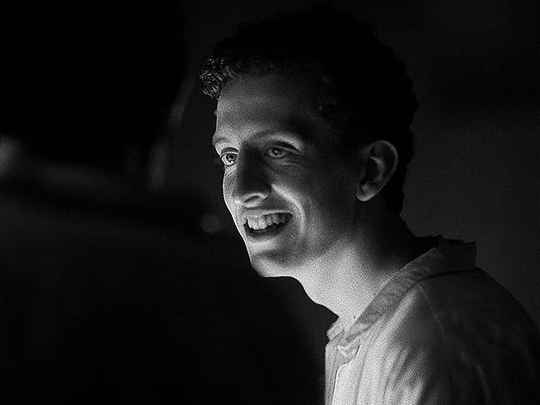
The next shot shows us more of the circular bokeh and another kind of lens flare.
For the bokeh, look at the lights on the ceiling as well as the corners of the out-of-focus architectural details (the semi-arches).
The lens flare here is the bouncing, blurry circle near the middle, as well as the brighter shape near the center bottom.
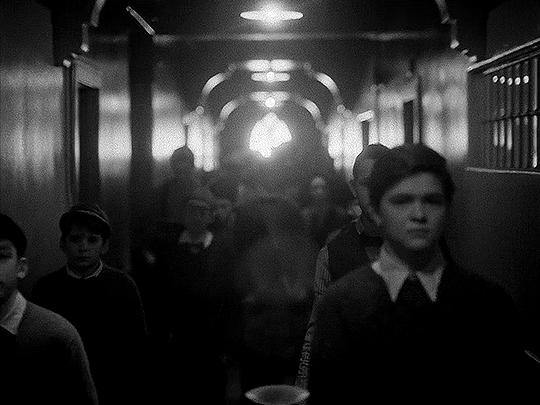
We can then look at the things that are not different, but absent when using the spherical lens: barrel distortion and focus falloff.
In this example, look at the windows in the background, as well as Edwin’s chair. An anamorphic lens would distort the vertical lines, bending them into a gentle fisheye. It would also make that chair and the lines of the window frames a bit blurry, as they’re close to the edges of the frame. Instead, the lines are straight and clear throughout the whole shot.
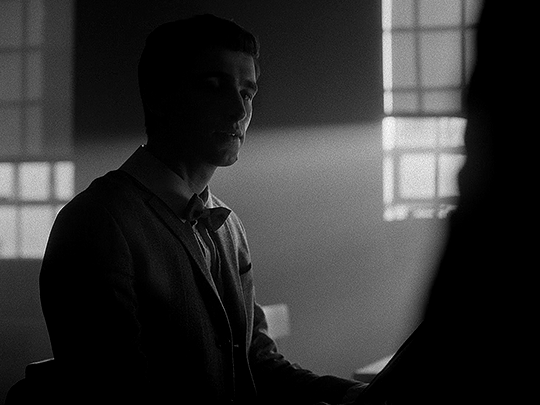
In this next example, not only do we get a great view of the lack of focus falloff, with clear lines throughout the shot, but we can see more of the difference in perspective and distortion of lines.
You may notice that the windows and doors are not perfectly straight up and down. But is this barrel distortion? If there was barrel distortion, the walls would curve back towards the center of the frame at the top.
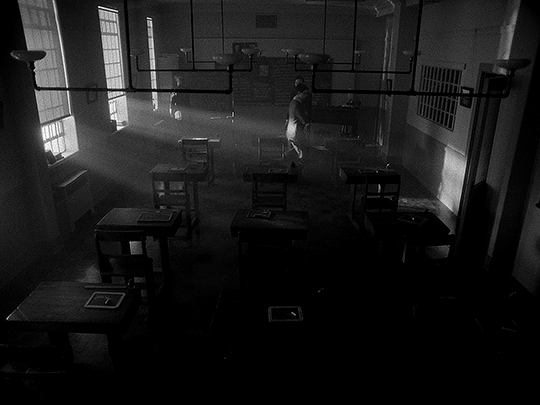
Spherical lenses are often the ‘default’ lens. They’re wonderful and used in a lot of media because they are neutral. They distort less, thus representing the world closer to how it actually is. If we consider the anamorphic lenses in the rest of the show being used to enhance the sense of supernatural and story, changing to a spherical lens enhances the sharp reality. This is Edwin, alive.
The image breaks out of its perceived container, reaching out to the audience, and then changes the lens to be more ‘real.’ In these two changes, not only do we have a more historically accurate image, but it's as if the creators are issuing a warning to us. Maybe the demon isn’t real, but bullies are. Kids can be cruel. Classmates hurt their queer peers. This is not fantasy, and this is as true in 1916 as it is today.
Using a spherical lens in this instance, juxtaposed to the rest of the show, is a dramatic shift to make, as it alters just about everything in the image. In using a less distorted picture, for this, we are reminded of reality and life and the mundane.
On Charles’ Flashback (and an experiment)
Edwin’s flashback got the Cinematography Treatment™ but what about Charles’ flashback? It’s shot with the same aspect ratio and lens as the rest of the show. From the perspective of historical accuracy, this is fine. It’s a scene that could have been shot in 1989, cinematographically speaking. The reason I suspect that it wasn’t given any stand-out look is because, unlike Edwin’s flashback, Charles’ flashback scenes are closely tied to the present-day plot. They aren’t just scenes of Charles remembering things, they are a direct result of the Night Nurse’s “memory magic.”
Maybe changing something here would separate us too much from the plot. Both flashbacks (in episodes 4 and 7) are induced for a specific purpose related to other present-day characters. It wouldn’t make as much sense to have them be standalones.
However, if I were simultaneously the showrunner, screenwriter, and cinematographer, I would give Charles a standalone flashback scene. In that flashback scene, here’s how I would shoot it:
There would be a much deeper depth of field/smaller aperture than the rest of the show, so the background would be more in focus.
There would be harder, less-diffused lighting. This would also impact the coloring, and I’d maybe add some more saturated lights.
I’d try to make an argument to shoot that scene on film (and then argue to do Edwin’s on film too).
There would be a different aspect ratio; 2.2:1 isn’t out of the realm of possibility for the 80s, but it wasn’t common, and it wouldn’t have the kind of impact I’m searching for if it didn’t change.
There are three different aspect ratios I would choose between, and the lens would change depending on my pick.
I’ve made some mock-ups for how these would look, though I cannot adjust things like bokeh and depth of focus, and I can only do so much with the lighting.
2.39:1 with anamorphic lenses (specifically Panavision lenses) This is a super standard widescreen, with a popular lens from the time. We don’t have lens info for the rest of the show, but I think they’re using Panavision anamorphics anyway so the lens may not be a change. Big, blockbuster action movies from the 80s would often be shot in this (perhaps most relevantly, Ghostbusters), and it���s a style that kind of faded in popularity in the 90s and 2000s, so it can have more of a retro look, especially if shot on film. One downside to this would be the aspect ratio change would not be as dramatic.
Movies from the 80s shot with this combo: Raiders of the Lost Ark (and other Indiana Jones movies), Star Wars: Episode V - The Empire Strikes Back (as well as Episode 4, which came out in the 70s. Episode 6 used the same ratio and did use anamorphic lenses, but not Panavision), Ghostbusters
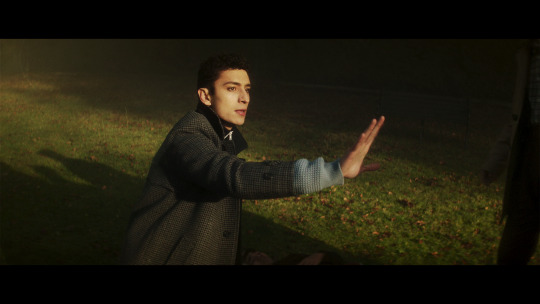
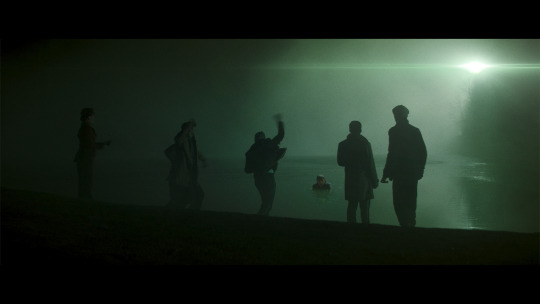
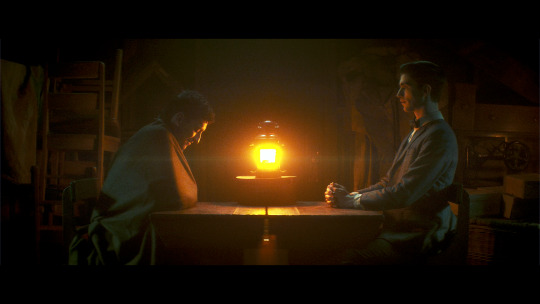
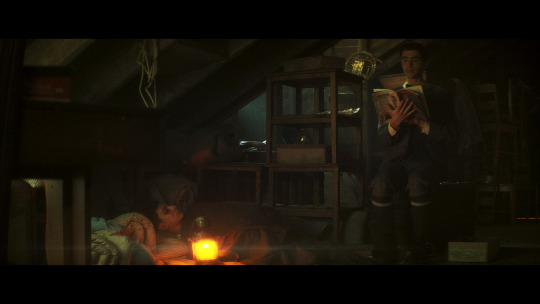
1.85:1 and spherical lenses. This is also ‘widescreen,’ but the advantage of using this aspect ratio is that we could get another dramatic breaking of the image container, just like in Edwin’s flashback. It’s an incredibly common setup, so it’s not really unique, but it would look different from the rest of the show. Given how pervasive ultra-widescreen still is today, I think a lower aspect ratio would also ramp up the ‘nostalgia’ factor a bit. Using a spherical lens we’d end up with the same sense of stark reality that we get for Edwin’s flashback as well (the warning that kids are cruel, but this time to people of color), and I like the idea of that as a parallel.
Movies from the 80s shot with this combo: Back to the Future, Dirty Dancing, The Princess Bride, An American Werewolf in London, Clue, Another Country
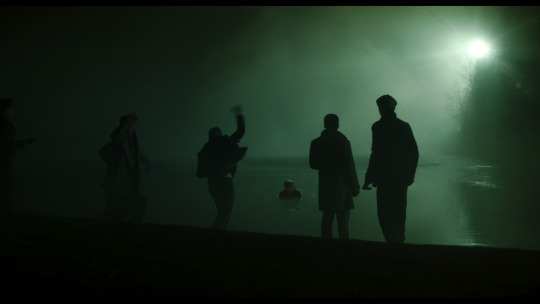
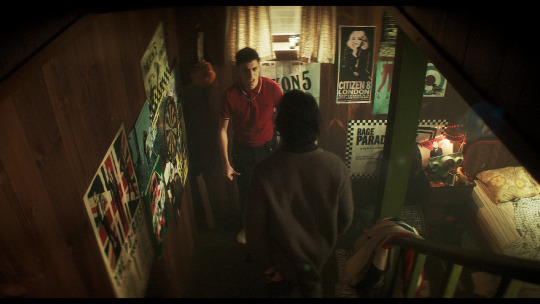
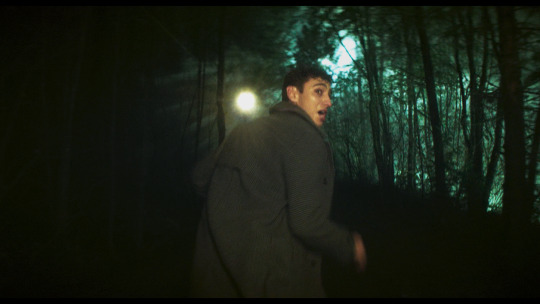
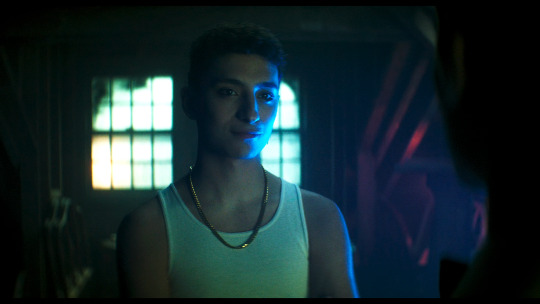
1.66:1 and spherical lenses. This is a ratio that was used widely across Europe, but has never been a common ratio in the USA. However, by the 80s, filmmakers were going for a more widescreen look so it was fading from popularity everywhere. The 80s liked widescreen, so it’s maybe not the best pick for making a scene look “80s”. However, my main motivation for this ratio is that my personal picks for the most Edwin-coded and most Charles-coded queer films are both 80s films shot with a 1.66:1 ratio. We would also get the same benefits from using the spherical lens as I mentioned in the 1.85:1 section.
Movies from the 80s shot with this combo: Maurice, My Beautiful Laundrette, Law of Desire (La ley del deseo), and an honorable mention to Chungking Express, a 90s film that really exemplifies the kind of look I'm going for here
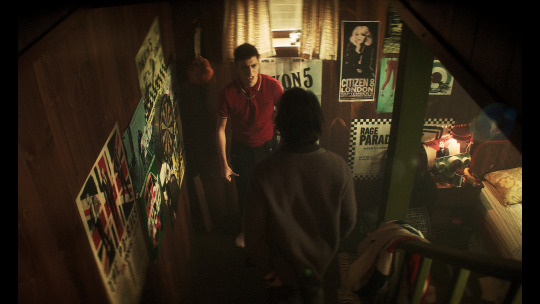
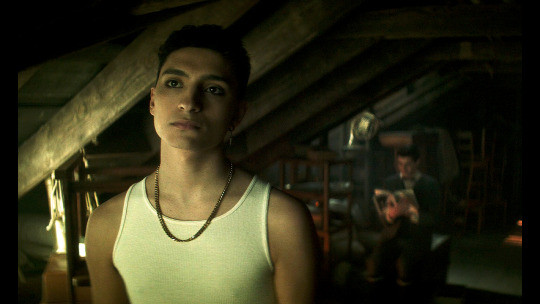
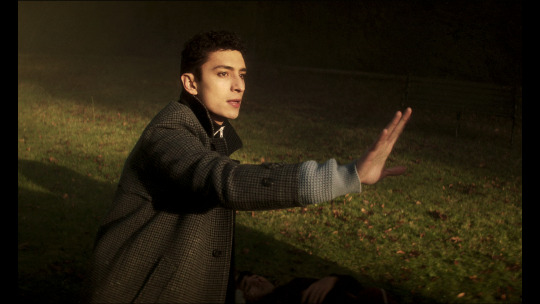
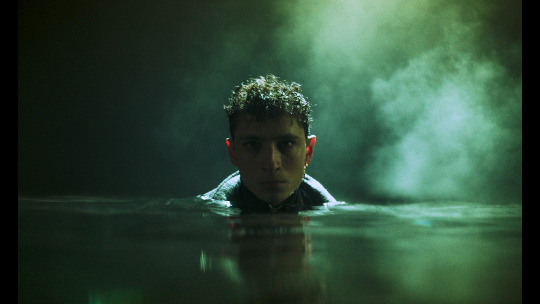
Giving Charles’ flashback a special treatment would probably do a lot to more firmly establish his character as a co-protagonist rather than a deuteragonist, which is definitely not the case but does seem to be how some people view him.
With the impact of the spherical lens and aspect ratio in Edwin’s flashback, the final two options for Charles flashback would be the closest in terms of echoing Edwin’s flashback, and would probably provide the most gravity and sense of crushing reality to the scene.
Setting a single scene (or two scenes) aside like this, with a unique aspect ratio, lens, and color grading (which I didn’t explore much for the Charles flashback), makes us consider a scene more independently from the rest of the show. Edwin’s flashback is a striking moment with a very different look, and that’s deeply memorable. It comes together to push how tragic and unjust Edwin’s story is.
—————
This concludes the planned portion of my cinematography analysis. I had a ton of fun researching and writing this (and making all the graphics) and I hope you all find this interesting/helpful/informative :)
Finally, I want to give another name drop to the cinematographers, Marc Laliberté, Craig Powell, and Pierre Gill. They’ve really nailed it from the very first episode to the last, and there’s so much intention and thought given to every aspect of how they shoot this.
#dead boy detectives#dbda meta#dbda#edwin payne#charles rowland#cinematography#dead boy detectives analysis#cinematography analysis#mygifs#dbdagifs
284 notes
·
View notes
Text
For The Glory of Rome
MARCUS ACACIUS X READER
You're finishing your senior year at Orpheus University when your history class is chosen to give an evaluation on one of the professors. Why does he feel so familiar?
⚠️ Past lives AU! Reader is Geta and Caracalla's sister! Reader is also 22 years old, Pedro is older. ⚠️
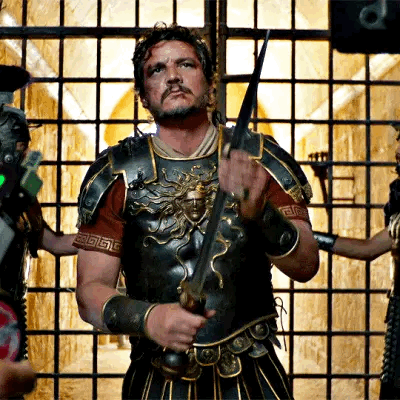
The mountains were just visible through the window you were sitting next to; their peaks reaching toward the sky above, almost as if in embrace. They were beautiful at this wintry time of year, with the snow cascading down their formations and painting them white. Bare trees that flanked them transformed into branches of green where the cold hadn't hit just yet- your eyes traveling further down the scene. It was that transitory period of the merging seasons, where autumn became winter and left everyone with an odd illness due to the changing weather patterns. Both snow and leaves were tracked inside the bustling classrooms that were alive with the excited chatter amongst the students. Everyone was excited for the upcoming break that would mark the end of the semester. For you, it would mean the midway point of your senior year at Orpheus.
You'd gone to Orpheus all three years of your college career so far, immediately entranced by the large stone pillared building it was. It was so different from your usual pace in the rainy countryside, with its suburban feel and authentic restaurants. It wasn't immediately that you felt the urge to explore the grand halls of the place and to make it your home, but that feeling came soon enough. One glance at the psychology department and a sip of coffee from the bistro down the road were enough to convince whatever part of you left unsure this would be the place. Even with how far you had to uproot yourself and make such a move, you'd made the connections you'd needed and the friends you'd always wanted.
Lee had sat himself next to you this morning with a coffee cup in hand and his phone in the other. He was addicted to that screen- any video that would appear around his recent interest in Danish pop music would be enough to send him down a spiral of excitement. The coffee, however, was for you.
"Morning!" He said, way too chipper for an 8:00am class. He usually went to Starbucks way too close to the time you were meant to be seated with only a minute left to spare. How he didn't have crippling anxiety around his time management, you'd never know. But he did bring you a drink.
"Hey, Lee." You said, with as much energy as you could muster at the moment given how tired you were. "Thanks for the coffee."
Lee threw his bag onto the ground under the long tables in the lecture hall. His spot had been on the other side of the room for the majority of the class as he'd argued he couldn't focus if seated next to you for laughter purposes. However, today he plopped himself down into the one next to you with his notebook open to the most recent material from last week. His hair was a mess as he'd most likely not had the time to brush it but at least his pants matched his shirt today.
"Yeah, 'course."
You took a sip of the drink, wincing slightly at the heat on your tongue. He'd remembered you liked your coffee black.
This morning, you had your history course which was conveniently in the building furthest from your shared apartment. Deciding the added three minutes to your walk would mean a warmer outfit for the day, you wore a white button down with fleece tights under your skirt. You had to substitute your usual leather jacket in favor for a heavier coat but still opted to wear the full face of makeup you had on every day. Eyeliner was your saving grace and you swore you'd never be caught outside without it on. You weren't much of a "girly girl," but that beauty product was the one exception.
Your shoes were still a little damp from the snow and the water had melted into the bottom of your bookbag, to your dismay. Your notebook was mostly fine except for the bottom edge, where the pen ink had run together, ruining your script.
"Did you hear about the evaluation today?" Lee asked, with his arm outstretched, offering you one of the Starbucks napkins to dry your notebook.
You hummed in a quizzing tone, signalling you didn't hear about it as you got to work cleaning up the mess before class started. There wasn't much you could do about the few pages that had been destroyed, but thankfully it wasn't the topic you needed at the moment.
"Well," Lee went on assuming you wanted him to continue, "Professor Klotsbach had to officially go on maternity leave so they're giving us someone else for the duration of this year. Apparently they're having this new guy come in today and we get to decide whether we like him or not." Lee said, rustling through his own belongings. "The history majors are saying this is the fifth one this semester."
"Oh? that'll be interesting. I didn't realize she was out already." You stated, throwing the napkins into your coat pocket. At least that meant this class would be easy today and you wouldn't have to worry too much about the notes. You took another sip of your coffee and turned your attention back to the large window to stare at the mountains again. The sun was really starting to come up now, which would hopefully make the walk home warmer. The sunlight shone over the leaves and made its way into the classroom, turning the wood paneling into that comforting auburn color you loved. Even with the weather outside, the inside felt like summer.
You directed your attention back to Lee, who was now back on his phone. You decided you weren't too tired for a conversation.
"I wonder why they're so particular about a professor for a general education course?" You asked, inquiring Lee as though he'd know the ins and outs of how the administration worked. Orpheus was always a semi-prestigious university; you wondered if they did so many evaluations for all the subjects.
"No idea," he said, taking a sip of his own drink, "I guess they wanted insight from other majors as well."
"Ah." You said, thankful that it would at least be some form of deviance from your usual schedule. After this, you and Lee had plans with the rest of your roommates to go to the bistro down the road so you considered today an easy one. A listening lecture followed by a sweet treat was a great morning.
As you were thinking of your plans, the door on the right side of the room finally opened, meaning the professor had officially walked in and class was about to start. Lee put his phone in his pocket although he didn't turn it off, so you assumed he was listening to music. You scavenged in your case for a pencil that wasn't broken and directed your focus to the front of the room, where the evaluated professor would begin.
Your breath hitched in your throat.
This man had to have been about ten years older than you but he was gorgeous. The brown in his eyes and his hair shone under the sun with such elegance; he appeared to be a painting. His brown leather jacket placed stylishly over his buttoned shirt- save for the two at the top- and his dress pants neatly drawn with a belt. An expensive one at that. He looked less like a professor and more like the cover of a teenage romance novel. Even his facial hair was properly trimmed and accentuated the angular curves of his face, which widened into a heartthrobbing smile.
"Hello, I'm Mr. Marcus." He said, turning around and writing it onto the chalkboard with whatever chalk was left in the tray from the class before. He then wiped his hands against each other and stood in front of the desk, leaning against it in an effortless grace as he stared at the class. His eyes scanned the room before they fell on you. It was only for a moment before he looked elsewhere, but you were starstruck and your stomach flipped.
Lee snickered quietly at the face you were making which took you out of your trance. "Dilf season, huh?"
Your cheeks were flushed and your whole body felt hot. It was unlike you to immediately be so caught off-guard. You shook it aside and attributed it to intimidation. That had to be it, you were just nervous of a new professor and at this guy's confident yet inviting demeanor.
"Shut up, Lee." You said with a small smile, so he'd know not to take offense although you were serious. You didn't want to draw any attention to your heart beating wildly in your chest.
As he continued talking, however, the burning in your abdomen only got stronger. There was something to this man, some sense of familiarity that struck you defenseless, although you were unsure as to why. You were certain you'd never seen the man before in your life, yet there was an undeniable pull that rendered you speechless for the rest of the class. He was wonderful at explaining everything in full detail and perfect when it came to answering questions. One thing was for certain though, and that was there'd be no way you could focus on any topic if Mr. Marcus was the professor. Despite how well he performed his job, you just couldn't concentrate. So, when the papers came around at the end of the class for the evaluation, you checked the box stating your disinterest in Mr. Marcus as your professor. How would you be expected to learn in a place where he was the teacher if you were so flustered? All you wanted to do was go home and decompress.
You submitted your paper to the front of the room, Lee in tow. You placed it face down on the desk even though the evaluations were anonymous; you felt awful for the decision you made. How was it fair for him to do everything perfectly and to not be granted the occupation?
As you were about to turn towards the door, you locked eyes with Mr. Marcus. They were a golden honey brown, very similar to the warmth of the room you were in, and they had you entranced. He smiled at you and raised his eyebrows as invitation for conversation, which was when you realized you'd been standing there in front of him with open eyes for longer than you meant to.
"Miss (Y/N), did you enjoy the lecture?" He asked, calm and composed. He must've read your name off the seating arrangement sheet and pieced two and two together.
"Uh, yeah-yes. Yes, I did. I find Rome pretty fascinating." You said, trying to regain your own composure. You smiled back at him in a last effort to appear normal and then walked out of the room and into the large hall where Lee followed close behind.
Alone in the Lecture Hall once all the students had departed, Marcus let out a hitched breath. You must have noticed it too? There was something so off about you and he was immediately drawn to your presence the minute he'd entered the room. It was as if he'd bumped into you before, only this odd feeling of familiarity was far more intense than anything he'd encountered before.
He learned against the desk for support and reached for the evaluation papers. He remembered exactly which one you'd placed down as he counted the number of sheets placed on top. He was unsure as to why he needed this clarification so badly, as if the evaluation was going to be enough insight as to how you truly felt about him.
You'd written that he performed everything perfectly. Checked all the boxes showing the administrators that he'd done as he should. But, at the end of the form, you'd written you didn't want him to have the job.
He smiled to himself, just slightly. He must've been overreacting.
...
It was with disdain that his eyes followed yours, the vituperative look etched into his skin. He appeared no older, even with the worry lines becoming apparent as he frowned; kohl seemingly molded into the flesh of his face with its darkness around his eyes. His tunic adorned with goldened jewelry held his red cloak fastened at his shoulder, which swiftly moved side to side as he walked about the palace floor. With his domineering personality and flamboyant demeanor, one could argue he very much belonged here. But those who truly knew him, such as you, would argue the complete opposite. A child in the body of man, ruling over the Roman Empire with the ability to kill any one of the men who'd built the imperial palace with the flick of his wrist.
And to think, he was your brother.
Emperor Geta manically moved back and forth, his steps echoing in the greatness of the hall where the two of you stood. Your other misfortune of a sibling somewhere entranced by his monkey, you presumed. Even with neither of them being much too intelligent, Geta was definitely the force to be reckoned with. This flurry of anger he felt was often of your own doing and today was no different- although the situation was more dire than previous mishaps.
What was usual sibling banter had turned into something fierce, unforgiving. It seemed as though the two of you no longer stood on the same plane and no words could be spoken to alleviate the tenseness between you two.
"There's a traitor-" He began, voice laced with more anger than anything else now that the shock had subsided. "Someone is helping the Senate to conspire against us. A traitor within the castle?" Geta dramatically flung his fingers over his heart and buried it into the fabric of his dress, steadying himself from falling as if he were intoxicated.
"I've heard nothing of the sort, brother." You let out, hardly above a whisper. It felt wrong for the secret to spill past your lips after all this time of keeping it. Although this had been going on for nearly five months, to speak it aloud even partially breathed it into existence. You, who had no family other than Geta and Caracalla, were plotting the demise of both of them. Rome was a collective and you'd been appointed to preserve the democracy of the people- something your brothers had turned into tyranny under their rule. However, it seemed as though they'd just caught wind of the plot without knowing who was leading the rebellion. Of course, Geta would eventually figure it out but the best thing you could do would be to deny anything that would lead to you or Acacius. He would have his head by morn and yours by the next.
Geta focused his eyes toward the nearest column so as not to look at you, forcing himself to tongue over the idea as it repeated within his head. His ornate laurel wreath crown he wore glistened in the light from above, casting a radiant glow on the floor. He was beautiful, if undeservingly so.
"Geta." You started, still fighting the fear that was always prevalent when conversing with your brother, "You are the emperor. Who would dare conspire against you?" you asked, knowing you had to do damage control. It all felt too real and too sudden for anything to happen just yet, this was unplanned. There was still so much more to be done and now that Geta had heard, Caracalla would be next to be informed- potentially halting the senate from being able to make a proper move. Your brothers would behead them all and force you to watch.
There had to be an informant within the Senate, someone who sided with your brothers in hopes of some grand reward for ratting you out. If they told Geta of the uprising, there's no telling how long it would take until they knew you and Acacius were leading it.
Suddenly, it was as if the color returned to Geta's white painted face. The creases that had formed out of worry now resumed with a smile so horrid and vile that your stomach seemed to drop to your toes with dread. The redhead inched closer to you until he was standing directly before you, inches away from your faltering breath. Smug look upon his face with his hands placed behind his back, he whispered in your ear the one thing you never wanted to hear from him.
"Make sure to relay this message to the Senate. If I hear of any further plans or catch the name of anyone involved within the operation, I will make sure the streets of Rome run red with their excrements."
Your veins turned to ice. It was as if your body had become as still as the marble statues surrounding the two of you. The sunlight hitting your brother's hair was not a warm and comforting light, but the light of a thousand fires ready to destroy anything within its path. You could smell the antimony from his makeup, and it was churning your stomach the longer you stood next to him. And then, he pulled you into a forceful embrace.
"You're my brethren, (Y/N). But bloodshed triumphs over blood. My mercy doesn't spill out of my fingertips such as the weak do. I am to carry on the tree of my lineage and I will do so from the seed of my power. Don't let me ever hear my dear sister has fallen into the conspiracy of the people."
Then he left, and a piece of your soul died with the slam of the door behind him.
...
General Marcus Acacius, still clad in the paludamentum from the evening's dinner, gathered himself after a lengthy conversation with some of his troops. He was fortunate for the day's conquer, but he was entirely ready to return to his chambers to meet with his love; hoping she could soothe the grievances that emanated from his soul. A slight glance into the reflection of the gate showed a man worn down by war. Physically and spiritually he felt beaten and old. His face, which had appeared so bright when he'd first started his efforts, had now succumbed to the weight he felt inside. He was duller than the man he'd always been. A light had been extinguished and would never again be set aflame. His body felt as though it were an empty chamber, hollow with only the sounds of the maternal screaming he heard from war. Mothers calling home their only sons that would stay calling for the remainder of their lives. Praying for the boys who'd become soldiers, fallen under an empire that prided themselves on greatness.
The Romans were cruel murderers. And he did their bidding.
Trying his best to push his stressors aside, he stepped into the small garden flanking the back perimeter of the palace, knowing that was your usual place upon nightfall. The fountain seemed to hum as the water rushed down into the basin. The sounds of bugs chirping filled his ears. The calmness of the fire tamed within the confines of the torches made flickering shadows upon the stones beneath his feet.
And then, there was you. Turning to face him once he'd entered the palace and meeting his gaze. He'd sworn he never understood the meaning of goddess until he'd met you. From the first encounter at the palace, Acacius knew he was in love. Every statue and painting couldn't compare to the beauty that radiated off you, he knew. Your eyes were pools of mystery and your skin softer than the sheets lining the bed you shared, fragile under the callouses of his hands that were worn by the hilt of his sword. You were a delicacy. He thought you were more striking than the sun itself.
The word love would never be enough to describe the power that flowed through his veins upon the mere mention of your name or the gentleness of your kiss.
You were here in your usual palla, the purple dye of the fabric shimmering under the soft glow of the fire. Your face was hardened into a concerned expression and your lips were downturned. What was usually a gleeful expression when your fiancé returned home safely seemed to be just a little short of animosity.
Acacius immediately went to place his hands gently at your sides, pulling you in slightly with a quizzical look, assessing for any physical ailments. "What troubles you, my Lady?"
You wanted to cry, to scream, to let out all your frustrations through vile words such as your brothers did, but you felt so beaten down you couldn't even formulate the words. Acacius had done nothing wrong but be within your proximity. And now your lover would be subjected to the unforgiving wrath of Geta.
"My Lady?" He asked once more, softer this time. He had a rough day, you could tell, and his forehead lines became more apparent as his brows furrowed. His beard was trimmed but not shaven, so as not to flaunt off some of the scars he'd gathered below his nose. He had one on his cheek and one on the back of his hand that you would run your fingers over in an intimate embrace. He was beautiful, even with the years of war embroidered into his skin. He was your heart.
"It's Geta," you finally mustered, holding Acacius's hand to your cheek and letting a tear fall, "he's enlightened to our uprising."
It was the General's turn to express his worry. "How was he informed?" Hs asked, pulling you in for a stiff hug as he was still wearing his breastplate.
"Macrinus must have caught word after last night's gathering. W-we were so careful, I-"
"Shh." Acacius said, slowly rubbing circles into your back, "We'll be okay, we'll find a way." He said this almost so convincingly you wanted to believe it yourself. But you knew Geta would do his best to punish you in every way humanly possible. There would be no escaping.
"We can run away before they find out its us-"
"To where? We both have the faces of those known in Rome, we'll never even make it past the gate without our identities being revealed. And then what? Where will we go that has no promise of being conquered?" He asked, holding onto you as though your arms alone would ground him. "And (Y/N), you know my heart belongs to you and the people. I couldn't leave one in place of the other."
Any form of democracy was going to be dead if your brothers continued to be the ultimate monarchs the were. Their reign had caused nothing but horrors to the people .
"Geta may want my head when he finds out, but he'll never kill you," Acacius said, looking into your eyes, "He'd never kill our kin." At this, his hand dropped to your stomach, caressing the top of it gently.
"You will not die without me." You said, knowing what he would suggest in the hopes of keeping you safe. "I will not allow it."
"And then what? You die and there will be no hope. Not for the people or politics or our son. My work to free us from the grasp of Rome will be for nought."
Your tears started to cascade down your face as quickly as they came, taking your kohl along with it. This was unfair. All of it was unfair. You wanted nothing to do with your brothers or ruling or Rome or anything. All you'd hoped for was to live peacefully in a world without it- how foolish.
"I love you, Acacius. You know this." You said, burying your face into his shoulder. You took in the metallic scent of his breastplate, trying to ease yourself. You knew as a general that he would never leave Rome defenseless.
"As I love you," he said, moving you gently so you were facing each other, "You know what has to be done."
You composed yourself and met his eyes, trying to find solace in them. He felt more like family than the insufferable gingers you shared a bloodline with. And you knew you'd do anything to protect the family you made for yourself, even if that meant sacrificing the birth one.
"We have to kill them." You said. You found the words didn't trouble as much as you thought they might.
#pedro pascal#marcus acacius#pedro pascal x reader#pedro pascal characters#pedro pascal fandom#marcus acacias x reader#marcus aurelius#gladiator ii#gladiator 2#gladiator movie#fanfication#fanfics#fanfic#writers on tumblr#ancient rome#roman empire
80 notes
·
View notes
Text
Get to know your Mutuals
Thanks for the tag @perlen-gold, even though I’m just an unhinged follower obsessed with your writing 🙈 I started my own chain so your original post wouldn’t get too long.

What's the origin of your blog's title? My thirst for Adar and the gauntlet kink he inspired.
Favorite Fandoms: I have a lot, but The Silmarillion/The Lord of the Rings/The Rings of Power are my main ones I always fall back on.
OTP(s) + shipname: I’m a self shipper so me + whomever I’m obsessed with (currently Melkor, Adar, and Gil-galad) but also more recently:
Melkor x Mairon (Angbang)
Adar x Celebrimbor (Silverscars)
Favorite color: Orange (also partial to purple and dark green).
Favorite game: Hero Quest (I’m not a console gamer. Though I did enjoy watching my husband play Horizon Zero Dawn).
Song stuck in your head: Dog Days (Are Over) by Florence and The Machine.
Weirdest habit/trait? Oh boy, where to begin… I make random noises, I meep like Beaker to songs, laugh at my own jokes… I’m just a weird person altogether folks.
Hobbies: Writing, visiting places of historical interest, I also used to be an avid reader but then motherhood robbed me of my energy and concentration. I listen to audiobooks more now.
If you work, what's your profession? I write scientific reports and run data tables for an Early Drug Development CRO, which is as fun as it sounds. I’m also a mother. Everything you’ve heard about motherhood is true and also a lie.
If you could have any job you wish what would it be? I would be rich enough not to need to work 🤷🏻♀️ or working on a petting farm would be cute.
Something you're good at: Berating myself. Encouraging others/being a cheerleader. Also writing, I hope 🙈
Something you're bad at: Most things, but especially anything requiring mathematics or physical exercise.
Something you excel at: Being a silly goose 😏thirsting over fictional characters 🙈 and raging at injustices. Erm, I think that’s about it. How tragic for me 😂
Something you love: The community I’ve found here on Tumblr 🫶🏼 period dramas, Dracula, and tattoos (I have none of my own… yet).
Something you could talk about for hours off the cuff: Mormonism, The Wars of the Roses, the people I love.
Something you hate: Injustice, mayonnaise, and corsets improperly portrayed in period drama.
Something you collect: Cuddly toy bats, and more characters to thirst over (I need help).
Something you forget: That motherhood is difficult so to give myself more grace.
What's your love language? I don’t adhere to love languages, but I guess genuine connection over similar interests, banter/in-jokes.
Favorite movie/show: Aaahhh don’t make me choose! It’s always changing.
Favorite food: Galaxy Cookie Crumble, Mini Eggs, Yorkshire puddings, and pizza.
Favorite animal: Bats 🦇
Are you musical? I can hold a tune and I played flute as a kid, otherwise sadly no.
What were you like as a child? Intelligent, saw everything in black and white, more artistic, more outgoing.
Favorite subject at school? History and art.
Least favorite subject? Maths and PE.
What's your best character trait? I like to think I’m kind and understanding.
What's your worst character trait? I can be so incredibly lazy.
If you could change any detail of your day right now what would it be? More sleep. Always more sleep.
If you could travel in time who would you like to meet? Bram Stoker. I’d also love to meet my mum as a young woman, I think we would have had fun.
Recommend one of your favorite fanfics (spread the love!):
Come by @perlen-gold (Angbang)
Of Convenience by @greenleaf4stuff (Silverscars)
Last but not least, show your favorite fanart of your favorite character(s) (please remember to credit/add links!):
Melkor/Morgoth

Adar

Gil-Galad (TROP)

No pressure tags for @greenleaf4stuff, @valar-did-me-wrong, @strifes13, @wowstrawberrycow, @iwanderbecauseimlost, @withallthatisleftofmyheart, @calmlyy-chaotiic, @margauxmara, @varda-starqueen, @saffronstories, @gingeragenda, @gracefallingart, @dwarveslikeshinythings, @whenimaunicorn, @permanentlyexhaustedpigeon88 and anyone else who would like to play! Sorry if I missed anyone.
#tag game#long post#get to know your mutuals#silmarillion#angbang#Silverscars#the rings of power#Adar#Melkor#Gil galad
68 notes
·
View notes
Text
THERE IS A GERMAN VERSION OF DESTIEL
hear me out:
So there is this very popular TV show called "Tatort" ("Crime Scene") in Germany. It's been on air since 1970 and all adults in Germany settle down on Sunday evening, 8:15 pm sharp to watch it. The episodes are usually about 90 minutes long. Each week we see a differnet team somewhere in Germany solve crimes and deal with personal problems and such.
Of course there can't be the same Teams over decades, so they change the characters over certain time periods. In 2020, Team Saarbrücken retired the main characters Detective Stellbrink and Detective Marx and introduced Detective Leo Hölzer and Detective Adam Schürk.

(Leo's on the left, Adam on the right)
And THOSE TWO GUYS are the German Version of Destiel. According to me, at least. I encourage you to Google them ("Tatort Saarbrücken" oder "Hölzer und Schürk") and watch their scenes. You don't necessarily have to understand what they're saying (there's usually just banter) just OBSERVE their interactions.
Nvm, YouTube only shows fanedits and crack videos.
DO YOU GET WHERE I'M COMING FROM!?
I'll give you one example here - those are literally their interactions, it's just with emotional music.
"I would go with you to the end of the world."
youtube
If you're interested in a little backstory: (trigger warning, child abuse)
Adam had a really fucked-up dad who would beat him more often than not. Adam met Leo in middle school when a couple jerks were beating up poor Leo. Adam knocked one of them down and since then, Adam and Leo have been best friends. One day, when Adam's Dad was particularly angry, he almost killed Adam with his punishments, when Leo showed up and struck the man down with a shovel. Adam's dad fell into a 15-year coma and Adam dissappeard.
Fast forward, first episode: Adam comes back and joins Leo's team in Saarbrücken. Leo is obviously pissed that Adam disappeared all those years ago and they have quite a rookie start. Nevertheless they fall back into their friendship dynamic, which is based on DEEP trust and an INSANE amount of loyalty. In an old-married-couple way. They both have their issues but they just kinda need each other (at some point Adam was accused of murder and Leo broke some laws to prove his innocence)
There's a lot of drama when it comes to these two and their dynamic is just so queer-coded it's driving many people insane. Like, the y don’t talk an out their problems AT ALL but they’re such an amazing duo when it comes to work.
Now, there are some problems:
We get about 1 or maximum 2 episodes per year. (Dont ask, it's complicated) Meaning, a new episode dropped recently and we have to wait another year for their story to continue.
And the recent episode (which ended in a massive cliffhanger) suggests that Adam might start a relationship with one of his female colleagues at some point in the future. Talk about homophobic writers.
This whole "Oh no, I suddenly don't seem to be in love with my best friend and spend a suspicious amount of time with a woman" is really weird because if you look at their history and their dynamic it just doesn't fit into the narrative! And that's even more annoying.
So yeah, I feel like I've seen this whole drama before. And I'm really fucking scared of its ending.
Also, am I the only one who this it's kinda cursed that in 2020, Destiel went down and in the same year, these guys arrived? I know thay don't have anything to do with each other, but the timing just makes me suspicious
#supernatural#destiel#dean winchester#castiel#Tatort#tatort saarbrücken#leo hölzer#adam schürk#hörk#not again#2020#spartort#I rhink I've seen this film before#and i didn’t like the ending#gay men#i am 100% serious
34 notes
·
View notes
Text
So, for the time being, I pretty much dominate the #alternate jewish history tag. By which I mean, all posts under this tag are ones I either wrote or reblogged. This is, of course, meaningless. Even so, I intend to take care of this little corner of my supposed kingdom, though invaders are fully invited. Please, it would be my pleasure if you add to this tag.
Either way, this tag currently has three AUs. As the purported owner of this tag, I intend to list them - while tagging the original creator when necessary.
The first AU is going to be the one I conceived of, naturally, since there can be no ownership disputations of it: the Jewsade.
The Jewsade is an AU based on the historical divergence of His Dark Materials. However, it's an AU worth exploring for its own merit IMO. Its divergence point is around the 1520s, with the Jewish false Messiah David Reubeni and Shəlomoh Molcho. In our world those two ended up eventually killed by the Spanish Inquisition; in the world of the Jewsade, they succeeded in getting the artillery David was trying to obtain and used it to conquer Eretz Yisra'el from the Ottomans. What happened with it later? Currently it's a riddle I can't answer, possibilities range from a disaster by the hands of the Ottoman Empire or Portugal to the continued existence of a Jewish kingdom in the Middle East, barely holding its own against both Christians and Muslims who want to take the Holy Land to themselves. Exploration of it is still at work, and I'm considering presenting it in random documents of various sorts from the period. It doesn't currently have a clear masterpost, I might work on that in the future.
The second AU I've put under this tag belongs to @aviad1b. This is the Hasmonean independence AU. It's not too well-built as of yet (and might also be related to the next AU, we'll see), but the basics are: the Hasmoneans don't give up their independence to the Romans and remain a kingdom for longer. This is a bit of a hard feat, because the Hasmoneans were sort of allies to the Romans even prior to that and the civil war is what caused them to turn to a passing Roman general to solve the dispute. After you avoid that... well, the Hasmonean dynasty still needs to keep its independence between the ever-greedy Rome and the rising Perthian empire, which is not going to be easy by any means. Even if they manage surviving one civil war... well, there will be others. However, it might be interesting to picture them somehow still prevailing, despite all the odds.
The third and more recent addition comes from @magnetothemagnificent's idea of a world where the 2nd Temple was never destroyed, the 2nd Temple Still Standing AU as I chose to call it, if you have different suggestions I'm open to hear them. A lot of the discussion on it includes the note of how much we don't know what the world will look like. Christianity might not exist, or be way smaller. The Jewish Diaspora would be way smaller adn would be mostly merchants. New technologies would be applied to old traditions and sometimes adjusted to them - the beacons to indicate the start of the month will stay, but their role would be fulfilled more with modern communication technology; flights to Eretz Yisra'el will commonly have space for cattle for the Korbanot; Cohanim would dominate the field of dermatology in order to be experts on Tzara`at, some working in construction (and some with textiles?) for the other types of it as well; religious institutions will be vastly different, with structures from 2 milennia ago surviving to the Modern Day in some form; Levyim maybe being dominant in fields of music and poetry; maybe melodies used for written texts in the place of punctuation; no written Mishnah or Talmud, things are mostly kept oral; and a lot more stuff.
There's the question, with that latter AU, of how that might happen. No rebellion against the Romans might be a possibility, though a bit hard to pull up. The Hasmonean Dynasty retaining independence can help, hence the reference I've made earlier. The Great Rebellion could also (maybe) fail before it escalated to the level of besiegeing Jerusalem. I really don't know. And unless you go by the "History is a rubber band" theory of time travel, there really isn't any way to know. So I suppose we should all just think about it a little more, and making stuff up can work, as long as you keep an eye on historical events.
Now, you might accuse me of certain hautiness in writing this. Please don't. Believe me when I say, I'm just enthusiastic about alternative Jewish histories, and would like to popularize the use of that tag. I would really like seeing farther AUs based on Jewish history - I had the pleasure to encounter a couple on Facebook, following a workshop on writing alternate Hannukahs in a meet-up organized by a group of interest on Jewish Fantasy in Israel. But there can be many more, and while I would love to contribute where I can and where my help is wanted, I prefer not to start any more than the one I'm already working on. So thank you to all the participants.
Note: the reblog chain for the Hasmonean Independence AU I shared here is only an exchange between me and Aviad. However, the 2nd Temple Still Standing thread includes (beside my and Magnetothemagnificent's posts) contributions from @alyssumlovesthecosmere and @fromchaostocosmos, hope you don't mind I'm tagging you as well.
#alternate jewish history#jumblr#judaism#jewblr#jewish fantasy#jewish sci-fi#(maybe)#jewish speculative fiction#jewish history#the jewsade#hasmonean independence au#2nd temple still standing au#2nd temple judaism#the hasmonean dynasty#david reubeni#shəlomoh molcho
36 notes
·
View notes
Text
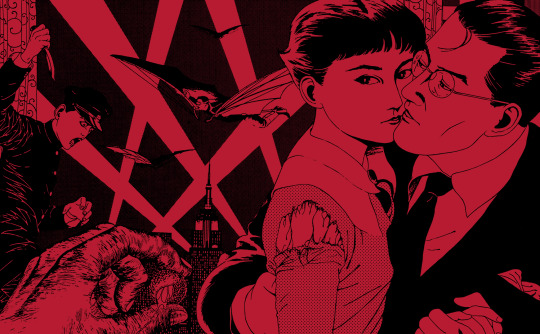
The Post-Futurist Fossils of LITCHI HIKARI CLUB In a somewhat recent research tangent, while considering the possible “genealogy” of the Tokyo Grand Guignol’s themes and aesthetics, I made an interesting personal discovery regarding Litchi Hikari Club. Specifically some distinct thematic parallels that the play shares with the Italian futurist movement, less in relation to the art of the movement itself, but rather the ideologies of the movement’s controversial founder, Filippo Tommaso Marinetti, and his relation to the Italian fascist party. This is all of course in the context of understanding Litchi as a transgressive/dystopian horror story. This is less of an absolute statement than it is a sort of open train of thought, so take things with a fair grain of salt. This is more or less just my own personal analysis of all the materials I could gather of the original play. Beyond inspecting the play as a possible allegory for futurism, there's also just a lot of general analysis of the play in relation to Ameya's overall body of work, both with the Tokyo Grand Guignol and also as a performance artist. I rarely put a 'keep reading' tag on these things since I'm an openly shameless product of the early days of blogging, but this one's a doozy (both in the information but also just the gargantuan length). Hopefully others will find it just as interesting. The full essay is below...
The futurist movement itself was nothing short of an oddity. In their time, the futurists were pioneers of avant-garde modernist aesthetics, with their works ranging from deconstructive paintings to reality-bending sculptures and even early pathways to noise music with the creation of the non-conventional Intonarumori instruments of Luigi Russolo. Russolo’s own futurist-adjacent manifesto, The Art of Noises, would go on to influence such artists as John Cage, Pierre Henry, Einstürzende Neubauten and the openly left-wing industrial collective Test Department. When visiting the MOMA in New York City as a child, I was fascinated by Boccioni’s Unique Forms of Continuity in Space, a sculpture that appeared to be a spacetime malformation of the human figure encapsulated in a continual state of forward motion while in total stillness. Despite this, the futurists were also a social movement of warmongering misogynists, with their own founding manifesto by Marinetti describing the bloodshed and cruelty of war as being “… the only cure for the world”. Their manifesto would also feature quotes such as “We want to demolish museums and libraries, fight morality, feminism and all opportunist and utilitarian cowardice”. They would originally pin anarchism as being their ideological ground in the manifesto, but shortly thereafter Marinetti would pick up an interest in fascism along with the politics of Benito Mussolini, going on to be a coauthor for the Italian fascist manifesto alongside the futurist manifesto. In consideration of how throughout most of World War II, modernist and post-modern works were considered “degenerate” forms of art in contrast with traditionalism, a whole avant-garde movement founded from fascist ideals is paradoxical. But for a period of time, that parallel wasn’t only in existence, but backed by Mussolini himself with there being a brief effort by Marinetti to make futurism the official aesthetic of fascist Italy. One of the draws of futurism for Marinetti was an underlying sense of violence and extremity. According to Marinetti, his initial inspiration for the movement was the sensations he felt in the aftermath of a car accident where he drove into a ditch after nearly running over a band of tricyclists. He conceived his works to be acts of social disruption, intending to put people in states of unrest to cause riots and similar bouts of violence. “Art, in fact, can be nothing but violence, cruelty, and injustice”. He sought to destroy history to pave the way for a rapid acceleration to futuristic technological revelation.

“As shown in Edogawa Rampo’s Boy Detectives Club, young men like to hide from a world of girls and adulthood to form their own secret societies.” - June Vol. 27 In Litchi Hikari Club, a group of middle school-aged boys are faced with a crisis on the brink of puberty. At the twilight of their childhoods, they form a secret society known as the Hikari Club (or Light Club), a collective that’s devoted to the active preservation of their shared youth and virginity. The boys naively mimic an authoritarian organization and its hierarchy as they seek a means to preserve their boyhood, which they see as being idyllic in contrast to adulthood, a dreary state of existence that they call old and tired in the Usamaru Furuya manga version of the story. Similarly, in the Litchi Hikari Club-inspired short manga Moon Age 15: Damnation, the boys go on to liken their hideout with the paradisiacal garden of Eden. In said story, Zera would directly name the poem Paradise Lost in reference to the discovery of their hideout by adults (arriving in the form of ground surveyors) and the wide-eyed daughter of a land broker, with their contact to the virgin industrialized land being an ideological tainting of the sacred lair. In their mission, they seek refuge in technological inhumanity by having their penises replaced with mechanized iron penises, symbolic devices of power and violence that can only procreate with other items of technology. Working in absolute secrecy, they collectively manufacture a robot known as Lychee. The purpose of Lychee, previously only known to Zera, isn’t revealed to the other club members until its completion. It’s when they unveil their “cute” robot in a scene that parallels the 1920 German expressionist film The Cabinet of Dr. Caligari that Zera tells the other members of Lychee’s purpose as a machine that would kidnap women for them. The robot's efforts are assisted by the girl capturing device, a strange rice cooker-shaped mask that’s laced with a sleeping drug. When questioned about the fuel source for the robot, Zera explains how it will run off the clean fuel of lychee fruits rather than an unsavory yet plentiful substance like electricity or gasoline as a means to further match the robot’s perceived beauty.
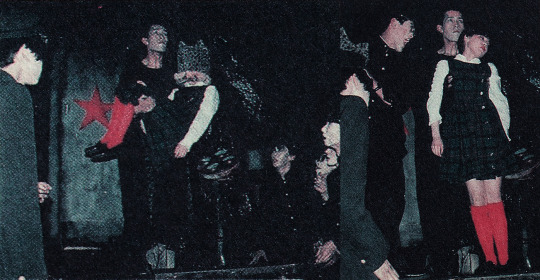
While the club share a general disdain for adulthood, they hold a special hatred to girls and women. Going off the dogmatic repulsion to sexuality that Kyusaku Shimada shows as the teacher in the Tokyo Grand Guignol’s prior play, Mercuro (1984), it could be assumed that the Hikari Club hold a similar dogmatic viewpoint about the vices of sex. In this context, it’s likely that they would’ve perceived women as being parasitic by nature as spreaders of the “old” and “tired” adult human condition through pubescent fixation and procreation. Sexual thoughts are inherent to aging for most people, given the process of discovering and exploring your identity throughout puberty. It’s that exact pubescent experience the club seek to eradicate. Further insight is given to the Hikari Club’s dystopian psyche through their open allusions to nazi ideology. While Zera travels out to gather lychees from a tree he planted, the club get a special visit from a depraved elderly showman known as the Marquis De Maruo, performed by none other than Suehiro Maruo himself in the 1985 Christmas performance. Despite the club’s disposition to adults, they hold an exception for the Marquis for his old-timey showmanship and open pandering to the children’s whims. He always comes with autopsy films to show the young boys, and as they watch the gory videos he hands out candies that he describes as being a personal favorite of the late Adolf Hitler. He was said to also be the one to convince the boys to name their robot after the lychee fruit. It isn’t until Zera returns that the Marquis is removed from the hideout on Zera’s orders. Just before his exiling, he foretells to Zera the prophecy of the black star as both a promise and a warning to the aspiring dictator. It should be noted that there is a fascist occult symbol known as the black sun.

Suehiro Maruo as the Marquis De Maruo. On the right side is a caricature of Maruo as drawn by a contributor to June magazine, excerpted from an editorial cartoon in June Vol. 27 covering Litchi's 1985 Christmas performance. In addition, the Marquis’ role alongside Jaibo’s appearances in the play (which I’ll get to later) show distinct parallels with the presence of the hobo in the Tokyo Grand Guignol’s first play, Mercuro. In Mercuro’s case, the hobo (performed by Norimizu Ameya, who would go on to also act as Jaibo) visits the classroom in secrecy to lecture the students his depraved ideologies. Whilst the hobo in Mercuro was a figure of perversion that existed in contrast to the teacher’s paranoid conservatism, in Litchi both Jaibo and the Marquis are enablers of the club’s fascistic leanings, with the Marquis being a promoter whereas Jaibo is a direct representation of the underlining perversions of fascist violence. Though completely omitted from the Furuya manga, the element of the autopsy films shines a unique light on Zera’s death at the end of the story. In both the play and the manga, Zera is gutted alive by Lychee when the robot undergoes a meltdown after being forced to drown Kanon (Marin in the original play) in a coffin lined with roses. In the manga, Zera appears deeply unsettled when realizing his intestines resemble the internals of an adult. It’s unknown if this aspect is present in the theater version, as the full script remains unreleased to this day. It would fit however knowing not just the club’s repulsion to adulthood, but also how they retreat to technological modification to eradicate the human aspects they associate with adulthood. What is described of Zera’s death in the theater version has its own disquieting qualities as, from what’s mentioned, when confronted with his own mortality he appears to regress to a state of childlike delirium, a demeanor that’s drastically different from his usual calm and orderly presentation. Upon seeing his intestines, one of the responses he is able to muster is “I’m in trouble”. He says this as he questions whether or not he can fit his organs back inside the cavity before eventually telling himself that he’s just tired, that he “need(s) to sleep for a while”.

While never directly stated, it’s heavily implied that the club’s ideologies and technological fetishism ultimately root back to Jaibo, an ambiguously European transfer student who secretly manipulates the club’s actions from behind the scenes. Referred to by Hiroyuki Tsunekawa (Zera’s actor) as the “true dark emperor” of the Hikari Club, he was said to haunt the stage from the sides, closely inspecting the Hikari Club’s activities while keeping a distance. The iron phallus was first introduced by Jaibo through a monologue where he reveals how he fixed one to his own person, carefully describing its inner mechanisms and functionality before demonstrating its inhuman reproductive qualities by using the phallus to have sex with a TV. A television that he affectionately refers to as Psychic TV Chan, in reference to the post-industrial band fronted by Genesis P’Orridge. In the same scene, he promises the other members that they would all eventually get their own iron penises just like his own. In a subsequent scene, he reveals the iron phallus’ use as a weapon when, arriving to the club’s base with a chained-up female schoolteacher who accidentally discovered the sanctuary, he uses the device to brutally kill the teacher through a mocking simulation of sexual intercourse. Just before raping her, he likens her to a landrace, bred for the sole purpose of reproducing and being processed into meat for consumption. He menacingly tells her that he will make her as “cut and dry” as her role in society before carrying out her execution. While there was some confusion on whether or not the iron phallus was a machine or solely a chastity device, it was found in bits of dialogue that the iron phallus at least shares the qualities of a pump with a described set of rubber hinges. The teacher’s death gruesomely reflects the death of Kei Fujiwara’s character in the later film Tetsuo: The Iron Man (1989), with the iron phallus mangling her insides as blood splatters across the stage. While the club treats adult sexuality as a plague, they manage to find through the iron phallus a way to convert their own states of chastity into a form of violence, stripping all humanity away from the penis and rendering it to a weapon of absolute power through desolate mechanized cruelty.
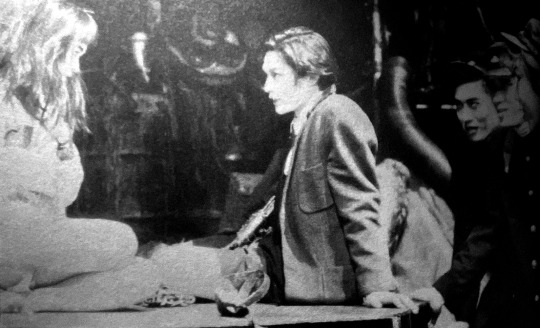
JAIBO: “Length, 250 mm, with a weight of 2.4 kilograms. Arm diameter, 30mm. Cylindrical thrust, 170mm… With pins, plates and rods of die-cast alloy. And hinges of rubber… the rest is pure iron. It is the iron phallus.” - June Vol. 27 In the same interview, Tsunekawa would go on to recall how the members of the Hikari Club were effectively Jaibo’s guinea pigs. In both the play and the manga, an after-school night of the long knives ensues with the slow collapse of the Hikari Club as Jaibo influences the exiling of certain club members, with Zera left ignorant to the social engineering as a mere extension of Jaibo’s elaborate puppeteering. Left embittered by a chess match where he lost to Zera, Tamiya is easily tricked by Jaibo into burning the lychee field as a way to get vengeance. Upon being caught, Tamiya is castrated of his iron phallus, resulting in his exiling from the club as a traitor while also being mockingly likened to a woman in the process. In another scene, it’s recalled that Jaibo and Zera exchange a conversation about the Hikari Club’s loyalty to Zera as they observe the outside world through their periscopes. By all contemporary recollections, Jaibo was the club’s puppet master. He would’ve been the likely source of the club’s ideologies, the underlining hatred to women and fixation on technological violence, replacing mankind with a race of humanoid weapons. Zera would be a shell without his influence. The presence of futurism could arguably even be rounded down to Lychee’s presence in the story. Beyond his theoretic work, Marinetti was also a playwright. He would be most well known for his futurist drama La donna è mobile, a story riddled with similarly perverse renditions of sexual violence. The play notably featured the presence of humanoid automatons a full decade before the term “robot” would be coined by Czechoslovakian author Karel Čapek in the play R.U.R., with the French version of Marinetti’s script referring to the machines as “puppets” for their visual similarity to humans.
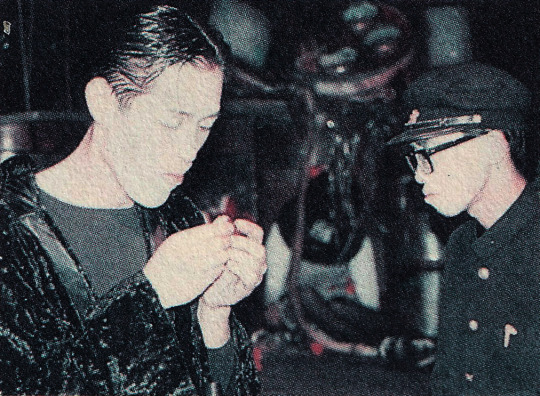
All of this plays out over a soundscape that’s dominated by unnatural electronic frequencies and synthesized percussion. The sound design was arguably one of the most important aspects of Ameya’s plays, with Ameya at one point describing the Tokyo Grand Guignol productions as being an ensemble of his favorite sounds. The setting further compliments the atmosphere, made to resemble the internal of a junkyard or factory warehouse where heaps of technical jump decorate the stage around the monochrome cabinet that would eventually birth Lychee. Some of the featured artists in the play’s first act include Test Department, The Residents, 23 Skidoo and Deutsch Amerikanische Freundschaft. The play’s opening, which depicts the capturing and subsequent torture of a student named Toba through a so-called “baptism of light”, is underscored by the S.P.K. song Culturcide, a grim primordial industrial dirge that paints the image of a dystopia where the genocide of ethnic cultures is likened to the infection of human cells by parasitic pathogens. Instead of being hung with a noose, Toba is suspended by a meathook, left as a decoration amidst the heaps of mechanized excrement. He would eventually be joined by the lifeless bodies of various women the Hikari Club abduct as they’re steadily gathered in a small box at the back of the stage. “Membrane torn apart, scavenging with the nomads. Requiem for the vestiges. Dissected, reproduced. The nucleus is infected with hybrid’s seed. Needles soak up, the weak must destroy. Cells cry out, cells scream out. Culturcide! Culturcide! Culturcide! Culturcide!” - Culturcide (from S.P.K.'s Dekompositiones EP)
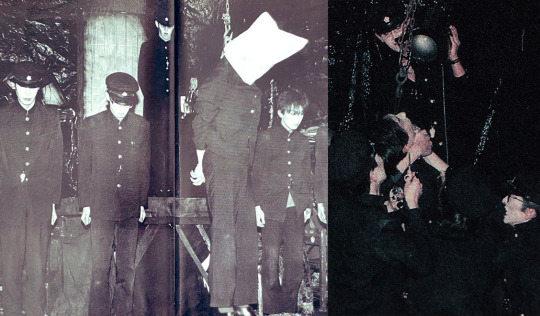
“We are now entering an era which history will come to call ANOTHER DARK AGE. But, in kontrast to the original Dark Age, defined by a lack of information, we suffer from an excess of information, which has been reduced to the repetition of media-generated signs. Through this specialization, it is no longer possible for an individual to attain a total view of society. Edukation is struktured to the performance of a limited number of funktions rather than for kreativity.” “Kommunications systems are designed for the passive entertainment of the konsumer rather than the aktive stimulation of the user’s imagination. Through the spread of the western media, all kultures come to stimulate one another. By the end of the millennium, this biological infektion will have penetrated the heart of the most isolated traditions - a total CULTURCIDE.” “Yet in every era, a small number of visionaries rise above the general malaise. Those who will succeed, will resist the pressure to become kommercialized “images”, demanding identifikation and imitation. They will uphold their principles in the face of impossible odds. By remaining anonymous, they will be free to develop their imagination with maximum diversity. For this is the TWILIGHT OF THE IDOLS, - the end of the proliferation of the ikons and the advent of a new symbolism.” - From the back cover of S.P.K.’s Dekompositiones EP (released under the moniker SepPuKu) Over the course of the play, the story undergoes a drastic tonal shift as the focus moves from the Hikari Club’s hierarchical order and internal conflicts to the relationship between Lychee and Marin. Marin (performed by synthpop musician Miharu Koshi) was the first girl the Hikari Club successfully kidnap through Lychee after implementing the phrase “I am a human” in Lychee’s coding so it can understand the concept of human beauty. This small implementation causes a full unraveling in Lychee’s personality as it quickly forms a close bond with Marin, convinced that it is also a human like Marin. The soundscape changes alongside the overarching atmosphere, going from cold industrial drones and percussive electronica to ambient tracks. Some of the major scenes play out over moving piano-focused pieces and music box tunes from Haruomi Hosono’s soundtrack for Night on the Galactic Railroad. Originally created a weapon like the iron phalluses and the girl capturing device, Lychee is eventually defined in how he transcends from being a weapon to a conscious being with feelings. In this context, the play can be read as a juxtaposition of human emotion against inhuman futurist brutality.
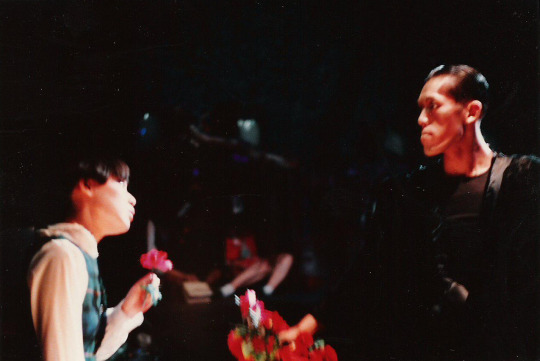
This split was likely the product of the radically different creative ideologies of Norimizu Ameya (the Tokyo Grand Guignol’s founder and lead director) and pseudonymous author K. Tagane (the playwright for the group from Mercuro to Litchi). Ameya had come into the group with radical intentions, holding Artaudesque aspirations to transgress the literary limits of modern theater to achieve something deeply subconscious. Meanwhile, Tagane was a romantic who was known for their poetic and lyrical screenplays. Ameya purportedly sought out Tagane’s screenplays specifically to find a literary base he would “destroy” in his direction, deconstructing the poeticisms in his own unique style. He describes it briefly in an interview regarding the stage directions of Mercuro, stating how he took elaborate descriptions of a lingering moon and ultimately deconstructed them to the moon solely being an illusion set by a screen projector, mapping out the exact dimensions of the projection to being a 3-meter photograph of the moon rather than a “fantastic moon”. It’s believed by some that the Tokyo Grand Guignol’s formation and ultimately short run were the product of a miraculous balance between Ameya and Tagane’s ideologies. It’s possible that Litchi could’ve been a last straw between the two artists. After Litchi, Tagane left the group, with Ameya having to write the troupe’s final screenplay on his own. LYCHEE: “Marin is always sleeping… all she does is sleep. She doesn’t eat anything. Why does Marin sleep all day?” MARIN: “When you’re asleep, all the sadness of the world passes over you.”

"The second half of Litchi was predominantly driven by the sounds of Ryuichi Sakamoto and Haruomi Hosono. During a scene that featured a piece from the Galactic Railroad soundtrack, Miharu Koshi sang to Kyusaku Shimada while dancing like a clockwork doll to the sounds of a twisting music box. The scene lasted for a while and was very romantic, the interactions between Lychee and Marin were all very sweet and cute. The second act of Litchi was all a product of Tagane’s making. By the time of the following play, Walpurgis, I was told by a staff member that Ameya had written the screenplay by himself because Tagane had left.” “… While the first half was filled with repeated mantras and the unfolding aesthetics of an aspiring militia, the second half was immersed in the world of shoujo manga. It did appear that through the intermission, much of the junk and rubble around the podium was sorted out.” “… The Tokyo Grand Guignol’s plays were always defined by a strong nocturnal atmosphere. But in Litchi’s second half, it wasn’t a dark night, but a brightly lit one under the moonlight and plentiful stars in the sky shining through an invisible skylight. Marin doesn’t forgive Lychee immediately for his actions, responding to him harshly in a way that would confuse him and make him sulk. It came across as a somewhat bitter reimagining of a French comedy like Louis Malle’s Zazie dans le Métro or Jean-Pierre Jeunet’s Amélie, it was different that way in how it wasn’t only Maruo’s inferno.” - From a Twitter thread by user Shoru Toji regarding the 1986 rerun of Litchi Hikari Club Some questionable qualities do exist in the relationship between Lychee and Marin. What should be a peaceful retreat from the dystopian corruption still has a sinister undertone in the disparities between Lychee’s cold masculine features in contrast with Marin’s childlike girly innocence. It doesn’t help that Zazie dans le Métro (one of the mentioned films in the recollection) was directed by Louis Malle, who while known for such films as My Dinner With Andre and Black Moon was also responsible for the infamously discomforting Pretty Baby. Then again, Litchi was the product of a confrontational transgressive subculture, so the sinister undertones could be intentional. Keep in mind the contents of Suehiro Maruo’s prolific adaption of Shōjo Tsubaki and how it unflinchingly depicts abuse and manipulation through the eyes of a confused child. It could be possible that Lychee himself was intended to be childlike in its mannerisms. Throughout the existing descriptions, Lychee was shown as speaking in fragmented sentences while struggling to understand basic concepts. Zera was mentioned to also use certain phrases like “cute” when referring to the robot when it was unveiled. And it’s through Marin that Lychee learns morality like a child. The robot’s masculinity could be passed off as the cast all being adults. Hiroyuki Tsunekawa for instance shows distinctly sculpted features from certain angles when performing Zera.
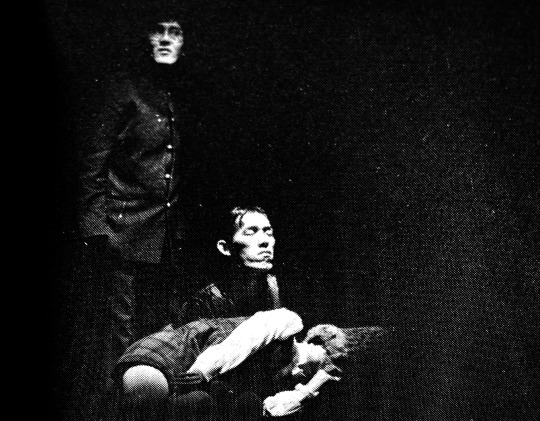
In his aspirations to become a human, Lychee eventually “dies” like a human. With the burning of Zera’s lychee tree, the robot is left with a finite limit on its remaining energy before it totally loses consciousness. After his rampage, Lychee attempts to reunite with Marin, but he runs out of fuel. Before what should be a moment of resolution, things are cut short as the stage goes black, eventually illuminated to show an unpowered Lychee cradling Marin’s corpse in his arms. Zera reemerges to observe the remnants of Lychee and Marin. He speaks of how Lychee will crumble into nothingness alongside Marin for foolishly giving into human emotion, further implying the club’s views on humanity. After this, recollections of the play’s final lines differentiate somewhat. It was said that in the original Christmas performance, Zera calls out to Jaibo, posing the corpses of Lychee and Marin as being his seasonal gifts to Jaibo. Whereas in most popular recollections, it’s described that after his monologue, Zera shouts “Wohlan! Beginnen!” (German for “Now! Begin!”) before prompting the decorations across the stage to collapse, revealing a set of stepladders from behind that the remaining previously deceased club members stand, all drenched in blood with spotlights illuminating their faces from below. ZERA: “And with that, our tale of a foolish romance between woman and machine reaches its conclusion. It ends before me as I stand here, watching. Lychee, the machine, will rust away into dust. And Marin, a young girl, will rot away leaving behind only her bones, which too will crumble…”
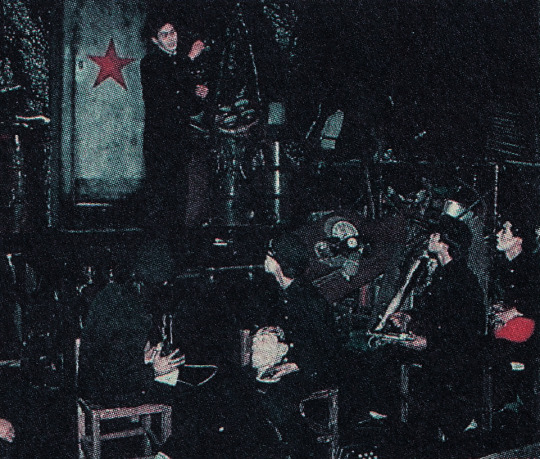
Multiple readings can be deciphered from this conclusion. The most established theory is in relation to the Hikari Club’s aspirations for eternal youth, with the members technically achieving their goal through the stagnation of death. They will remain eternal children since they died as children, unable to ever grow into adulthood. In the context of futurism and mechanized fascism however, it could be read as a bitter observation of a lasting dictatorship. With how the Hikari Club members had rendered themselves less human than their own robot, they survive death to continue their work, seeking to one day eradicate humanity in favor of a race of sentient childlike weapons. “To admire an old picture is to pour our sensibility into a funeral urn instead of casting it forward with violent spurts of creation and action. Do you want to waste the best part of your strength in a useless admiration of the past, from which you will emerge exhausted, diminished, trampled on?” “… For the dying, for invalids and for prisoners it may be all right. It is, perhaps, some sort of balm for their wounds, the admirable past, at a moment when the future is denied them. But we will have none of it, we, the young, strong and living Futurists! Let the good incendiaries with charred fingers come! Here they are! Heap up the fire to the shelves of the libraries! Divert the canals to flood the cellars of the museums! Let the glorious canvases swim ashore! Take the picks and hammers! Undermine the foundation of venerable towns! The oldest among us are not yet thirty years old: we have therefore at least ten years to accomplish our task. When we are forty let younger and stronger men than we throw us in the waste paper basket like useless manuscripts! They will come against us from afar, leaping on the light cadence of their first poems, clutching the air with their predatory fingers and sniffing at the gates of the academies the good scent of our decaying spirits, already promised to the catacombs of the libraries.” - from the 1909 Futurist Manifesto by Filippo Tommaso Marinetti

I forgot what exactly first caused the parallel to cross my mind. I do recall it being reignited when having a closer look over the poster and flyer for Litchi’s Christmas performance in December 1985. The flyer in particular is really a wonderful thing to look at. Predominantly featuring an art spread by Suehiro Maruo, a suited man with Kyusaku Shimada’s likeness is shown caressing a girl in front of a modernist cityscape with spotlights shining up to a night sky. Other suited men in goggles fly in the air with Da Vinci-reminiscent flying apparatuses between the beams of the metropolis’ spotlights. A student in full gakuran uniform flings himself into the scene from the far left side of the image with a dagger in hand, and a larger hand comes from the viewer’s perspective holding a partially peeled lychee fruit. While not based on any direct scene from the play, it perfectly instills the play’s atmosphere with an air of antiquated modernity, like the numerous illustrations of the early 1900s that show aspirational visions of what a futuristic cityscape might resemble. The bizarre neo-Victorian fashions of the future and its post-modernist formalities. The term futurism came to mind somewhat naively from this train of thought. It was a movement I recalled hearing about, but my memory of it was hazy. It wasn’t until I went in for a basic refresher that I felt the figurative lightbulb go off in my head. That was when the pieces started to come together, but then also strain apart from each other into tangents. Granted, many of these parallels could be read as coincidental. Many of them can even be passed off the play being a work of proto-cyberpunk, knowing how Tetsuo: The Iron Man would subsequently explore similar themes of cybernetics and human sexuality. It should still be noted however that in contrast with many of the Japanese cyberpunk films, Litchi was explicit in its connotations between technological inhumanity and fascism, with the machinery itself being the iconography of a dictatorship rather than a product of it. In addition, with Tetsuo the film has strong gay overtones, with the technology being an extension of the sexual tensions between the salaryman and the metal fetishist. For a period of time, efforts were made to make futurism the official aesthetic of fascist Italy, and modern fascism as we know it is in the same family tree of Italian philosophy as futurism. The Hikari Club are explicit in drawing from German aesthetics rather than Italian however, speaking in intermittent German and predominantly using German technology. The spotlight that they used when torturing Toba in the first act, for example, was a Hustadt Leuchten branded spotlight. And if that isn’t a German name I don’t know what is. It was also said that Jaibo’s outfit in the play was modeled after German school uniforms. Though then again, the Tokyo Grand Guignol’s works were a bit of a cultural slurry. Jaibo’s name for example is Spanish (derived from Luis Buñuel’s Los Olvidados), while the character is implied to be German.
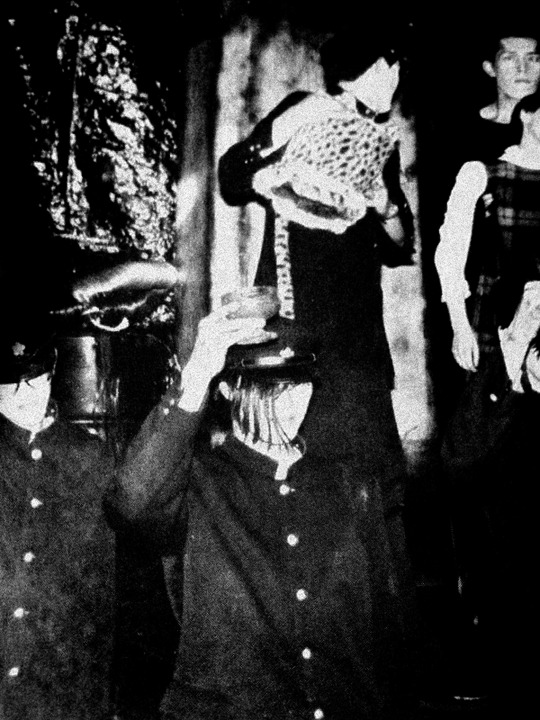
Similar to the cited origins of futurism, Ameya stated in a 2019 tweet regarding the June 9th, 1985 abridged Mercuro performance on Tokumitsu Kazuo’s TV Forum that in the following August of that year, an airplane accident occurred that led to the conception of Litchi’s screenplay. The exact nature of the accident was never specified, but the affiliates he was communicating with all appeared to be familiar with it and expressed concern when it was brought up. This was however one of an assortment of influences that were cited behind Litchi’s production, with the two more established theories regarding the then-contemporary mystique around lychee fruit in Chinese cuisine along with the play being a loose adaption of Kazuo Umezu’s My Name is Shingo. For what it’s worth, the themes of Litchi, along with the Tokyo Grand Guignol’s other works, were closely tied with certain concepts that Ameya personally cultivated throughout his career. A frequent recurring topic Ameya would bring up in relation to his works was the nature of the human body in relation to foreign matter, need it be biological or unnatural. With Mercuro the students taught by Shimada are made into so-called Mercuroids by having their blood supplies replaced with mercurochrome, a substance that is referred to as the “antithesis of blood” by Shimada while in character. In an interview for the book About Artaud?, Ameya cites an interest in Osamu Tezuka’s manga in how certain stories of Tezuka’s paralleled Ameya’s observations of the body. He directly names Dororo and Black Jack, observing how both Hyakkimaru and Black Jack reconstructed their bodies from pieces of other people, going on to bluntly describe Pinoko as a “mass of organs covered in plastic skin”.

A section from June Vol. 27 highlighting some of the more established performers from Litchi's 1985 Christmas performance. The actors from left to right are Norimizu Ameya as Jaibo, Naomi Hagio as the female school teacher (best known in cult circles for her role as Kazuyo in the 1986 horror film Entrails of a Virgin), Suehiro Maruo out of costume and Miharu Koshi as Marin. During his temporary retirement from theater, Ameya would take up performance art, with some of his performances revolving around acts with his own blood. While my memories of these works are a bit hazy, I remember one action he performed that involved a blood transfusion, with the focus being on the experience of having another person’s blood coursing through your veins. While I didn't have much luck relocating this piece (probably from it not being covered in English), I did find on the Japan Foundation’s page for performing arts an interview where Ameya discusses being in a band with Shimada where Ameya had blood drawn from his body while he played drums. He would also describe an art exhibition where he displayed samples of the blood of a person infected with HIV. “After 1990 he left the field of theatre and began to engage himself with visual arts - still proceeding to work on his major topic - the human body - taking up themes like blood transfusion, artificial fertilization, infectious diseases, selective breeding, chemical food, and sex discrimination, creating works as a member of the collaboration unit Technocrat.” - Performing Arts Network Japan (The Japan Foundation) There are still an assortment of open questions I’m left with in regards to the contents of the original Litchi play. One of the most glaring ones is Niko’s eye. In consideration of Ameya’s interest in the body, the detail would fit perfectly with his ideologies. A club member who, to show his absolute loyalty to the Hikari Club, has his own eyeball procedurally gouged out to be made a part of the Lychee robot. Despite this perfect alignment, none of the contemporary recollections mention this element. While Niko does have an eyepatch in certain production photos, it never seems to come up as a plot point. He isn’t the only one to bear an eyepatch either, with Jacob also being shown with an eyepatch in flyers. More questions range from Jaibo’s motives in causing the dissolution of the Hikari Club to the true nature of Zera’s affiliation to Jaibo. While Tsunekawa has stood his ground in the relationship between Zera and Jaibo being totally sexless, in the cited volume of June the editor playfully refers to Jaibo as being Zera’s “best friend” in quotes.

A side-by-side comparison of the cast listings on the back of the flyers for the December 1985 performance of Litchi Hikari Club alongside its 1986 rerun. The 1985 run's lineup is at the top while the 1986 run is at the bottom. Much speculation is naturally involved when looking into the original Litchi Hikari Club since it is in essence a cultural phantom. There’s a reason I used the term genealogy in relation to my research of the Tokyo Grand Guignol’s works. It is an artistic enigma as while its presence lingers in subculture, the original works are now practically unattainable due to the inherent nature of theater. As Ameya himself would acknowledge in another interview, theater is an immediate medium that can only be perceived in its truest form for a very short span of time before eventually disintegrating. So with the Tokyo Grand Guignol’s plays, you are left to scour through the scattered remnants and contemporary recollections alongside the figurative creative descendants of the plays. You analyze the statements of both the original participants and the people they openly dismiss, as even those people were original audience members before reinterpreting the plays to their own unique visions. Despite the apparent differences, I still feel that Furuya’s manga gives a unique perspective to the story when viewed under dissection. That is if you want to see it in strict relation to the play. Outside that, I feel it firmly stands on its own merits. I like the manga no matter what Tsunekawa says, that’s what I’m trying to say. Ameya approved it anyway. It took me a full day to write all this out, and like the first time I went down this train of thought, I’m pooped. During that first excursion, after excitedly spiraling through these potential connections, I noticed in passing mention something about Marinetti’s cooking. You see, later in his life Marinetti aimed to apply futurism not just to art and theater, but cuisine also. As an Italian, Marinetti openly despised pasta, seeing it as being an edible slog that weighs down the spirits of the Italian people. Just further evidence that I would never get along with the man, no matter my liking of the Boccioni sculpture I saw at MOMA all those years ago. Well, outside of him being a fascist and all obviously. I like pasta. Either way, he was on a mission to conceive all-new all-Italian cuisines that would match the vision he had of a new fascist Italy. Nothing could prepare me though for when I saw an image of what would best be described as a towering cock and ball torture meat totem. It is exactly as it sounds, a big phallic tower of cooked meat with a set of gigantic dough-covered balls of chicken flesh on the front and back where you have to stick needles through the thing to hold it together. Words cannot express just how big it is. The thing was damn well near falling apart from how unnatural its shape was, and you’re expected to eat it while it has honey pouring from the tip of the tower. I genuinely winced watching its assembly, I instinctively crossed my legs somewhat when it was pierced by wooden sticks and then cut into sections to reveal the plant-stuffed interiors. As a person with no interest whatsoever in cooking shows, I was on the edge of my seat watching a PBS-funded webisode of someone preparing futurist dishes. Seek it out for yourself, it’s an excessively batshit culinary freakshow. That is more than enough talk about penises for the rest of the week. I’m going to spend the next few days looking at artistic yet selectively vaginal flowers to balance things out, equal opportunity symbology.

288 notes
·
View notes
Text
2024 feminist movie retrospective ~ day 11
It's RAPID FIRE REVIEWS TIME !! ROUND 4
I don't have enough to say about these next films to write full reviews, but i still want to mention them, these are some of the ones i watched in theaters in July/August/September of 2024.

A really fun, compelling fictional story set in a real historical concept i had no knowledge of. Super interesting, beautiful locations and a close look at a culture we almost never get to see in movies. Loved that one! Very beautifully shot, good acting, interesting characters. THE best movie ending of the year bar none. I strongly recommend this one!! It's a very easy, satisfying watch that will appeal to all of you i think.
trailer

Back when the first movie came out, I was a bit disappointed. It was a good film, but I thought it was predictable and it tried too much to be a horror movie (and failed miserably at it). I enjoyed AQP2 much better, and this new one kept everything I liked from that one! It's pretty fun, it has tense moments, it has a beautiful conclusion, so overall a pretty good time :)
Lupita Nyong'o is fucking stellar as usual. Her character is interesting and pretty complex and her performance really sells this story. There's so much dignity and depth to her character, and it's a very original choice for a sci-fi thriller protagonist. I know a lot of you enjoy weak pathetic men, so you'll like Joseph Quinn in this I think. He looks AND acts like a sad wet cat lol. Speaking of cat, it must have been difficult to shoot but the cat actors who play Frodo are very good! So cute <3
The writing isn't perfect (some moments are a bit too easy and convenient) but if you enjoy creature movies, stressful movies and/or you love cats I recommend it! I love that kind of shit
trailer

With 9M tickets sold, this was the second biggest movie of the year in french theaters ; and what can I say except FRENCH CINEMA IS BACK BABYYYY!!!!! Extremely well shot, beautiful music, great acting, very elaborate and interesting costume designs and crazy locations... Even I who doesn't like period dramas had an absolute blast. I can't believe this is three hours long. The rhythm is so good that it didn't feel like that at all, it flew by.
So. Funny story, i thought i knew what the story of the Count of Monte Cristo was..? But as the plot kept going, i was thinking to myself "damn, the part i know must be pretty late in the film because i don't recognise anything." And well, that's because what i thought was the Count of Monte Cristo was actually the story of The Phantom of the Opera... 😭😭😭 as you can probably tell i'm more knowledgeable on movies than classic literature... But it's good because I was able to be surprised by every twist and turn, as I actually didn't know the story at all. The writing is terrific. Those dialogues... Chef kiss. WATCH THIS!!
trailer

THE weirdest project of the year for sure. WHO greenlit this?? They deserve a raise. This was HILAAARIOUS. The two main ladies are such original and interesting characters and the actresses (who are not famous at all) deliver one of the best performance of the year. I'm not kidding. Very interesting film-making choices, very snappy and fun dialogues, super weird and unusual characters. While it is one continuous story, the way the scenes play one after the other makes it feel like a compilation of short films (especially with the nature of the cast, it's a lot of french comedians and miscellaneous celebrities). The whole story is inspired by a crime that happened in France (probably the most famous one in recent history (i provided a link but be warned, this is about a family annihilator)) and specifically inspired by a news story where a man was mistakenly identified as the prime suspect of that crime even tho he looks nothing like him. Some parts of the film get way, WAY more dark than i could ever have expected. We see the crime happen and it's absolutely nightmarish but also super interesting, i loved the sound design. Some scenes are also downright gore and sordid. But i loved it. You wouldn't think it works to mix all these different genres in one film but it does. The film walks a fine line between creepy and funny and it does it perfectly. Can't wait to watch that one again.
While you can try if you want, i do not recommend watching this film if you're not french. Sorry. I don't think the humor holds up if you don't have the cultural references and don't know the cast. Also i just don't think the humor would translate well.
trailer

I do NOT understand why so many people hate this one?!?! Keep in mind that this is my first Ti West film, so i have nothing to compare it to. I haven't seen the rest of the "Mia Goth trilogy". But this was very fun? This is a very strange concept, it's basically an anti-horror movie. Like, every time something or someone threatens this woman, SHE destroys it. Litteraly in the first 20min there's a bloke who tries to mug her and she CBTs him graphically. Like wtffff 😭😭😭 I LOVED IT. Maxxxine might be one of the most iconic female characters of the year.
The way the film handles prostitution feels very liberal, empowerment and all that. But besides that the main character is unexpectedly treated very respectfully? Prostitution only appears in the first act if i remember correctly. We only see one graphic sexual act and it's on screen for like 10 seconds, and it doesn't involve the main character. She never gets even partially naked, like at some point she is asked to show her breasts at a casting call and it just cuts away pretty naturally. When there's gore and physical violence on screen, it's more often than not against men. Definitely an oddity for the horror genre.
The film is also a pastiche of 70s/80s cinema and it works super great. It's shot on film and it looks beautiful, the editing and the sound design are very intentional and purposeful, it's all well thought out, down to the credit that appear with this super recognisable hue around the text, this brings you back to the 70s instantly. The performances are top notch. Elizabeth Debicki is great as usual, Mia Goth is off the charts. She oozes style and charisma. The film has a super fun and satisfying ending, i loved the commentary about the satanic panic. I'm very curious about the rest of the trilogy now! I'll try to watch it this year. I really liked this project ! Maxxxine marry me
trailer
That's it for July/August/September ! I also went to see Fly me to the Moon, Horizon: An American Saga – Chapter 1, Les Fantômes and The Trouble with Jessica but i have nothing whatsoever to say about them...
17 notes
·
View notes
Text
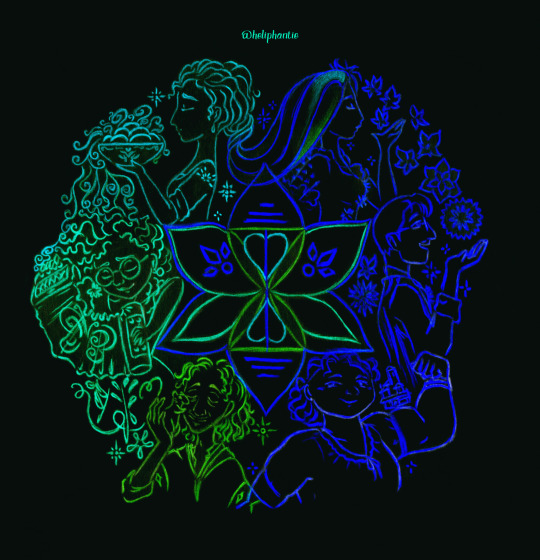
Happy second anniversary of Encanto movie!
I had (then and year ago) more ambitious idea of mock poster, but again, to execute it properly, decided to put it aside until skills and tools for it gained. So I opted for the piece reflecting on my personal take from the story.
The drawing is an experiment, drawn traditionally in complementary colors and put through color inversion in an editor.
I’m not a fandom person, admittedly. What piques my interest in exploring of piece of fiction is, usually, is its origins, history of creation, cultural background and, in some cases, impact it leaves on the art coming after it, rarely anything beyond. With all things I’ve had getting into recently, it was like that, generally observatory things. When I’ve got into MLP, it was a phenomenon of its large fandom, sheer variety of art forms it produced (from the music and games to automata toys), people of different upbringing and cultures being all inspired by it – fascinating to witness such a movement in present time. With The Simpsons, it was its legacy, its large influence in modern media – seeing the roots, the blueprint of it, getting understanding of why it was such a powerful piece of storytelling and visual direction to raise the cult around it. With Encanto, it got me curious at first to see aesthetic of magical realism being translated in form of animation, and I was surprised Disney decided to dip their toes into attempt of it. Generally, I’m more enticed by potential of the story and its artistic presentation, most of it is left in concept studies rather than in finished work, as often in mainstream production, possibilities and imagination and artistic talent poured into it is much more stunning than the product released to the public. I may feel reasonably cynical about modern Disney as company, but I can’t deny the imagination and immense genius of professionals who are still at work in it. I wish we’ll see the true Renaissance of what always was its major power - traditional animation.
So, what’s the outcome of it: while any piece of fiction that wins my full attention does make my creative juices flowing, nothing of it got to see the light of day until I felt the urge to express what was brewing in my mind affected by that new and hot thing, not to a lesser extent getting inspired by other people’s concurrent creative works, it did kick off renewal of drawing practice I had abandoned years ago and continued postponing for indefinite period. It still induces me to work toward my own progress, for it provides me with backlog of ideas to make into drawings when I really need motivation. It’s going to keeping up, hopefully, until some other thing sweeps me away or something makes my enthusiasm fade. And so, the movie in question is what had the most productive impact on me so far, it helps me keep going, and I’m grateful for that.
On the different note, Bruno in this image is based on Disney Magic Kingdoms's Encanto event video:

#encanto#encanto fanart#disney fanart#bruno madrigal#julieta madrigal#agustín madrigal#isabela madrigal#luisa madrigal#mirabel madrigal#la familia madrigal#madrigal family#phantieart
159 notes
·
View notes
Text
SSP PLUGIN RECOMMENDATIONS
Do you want to customize and expand your desktop buddy experience further? here are some handy links to miscellaneous plug-ins I’ve gathered from around the web, or you can even program your own, and they can also be written in any programming language so the possibilities are limitless! plug-ins are essentially extensions or add-on built for SSP. I’m not a plugin developer myself, and have yet to test out each one of them for extended periods of time, so please refer to the readme files/ instructions provided by the developers (github usually has info) on how to use them if you get stuck or encounter issues. these are just some of the more recently updated ones, I'll be (slowly) adding more to the plugin page of my blog if you're interested!
Do you want to customize and expand your desktop buddy experience further? here are some handy links to plug-ins I’ve collected from around the web, or you can even program your own, plug-ins are essentially extensions/add-ons or additional features for the SSP baseware. there are a wide variety of different Ukagaka compatible plug-ins out there that this list hasn’t scratched the surface of yet, some even make it so seperate programs (Discord, music players such as WinAmp or Foobar2000, encoding software) can interact with Ukagaka. a few newer ones require third party (free) software like VOICEVOX or API keys but the majority are designed to work with just the plain baseware (SSP) but refer to the individual readme files and instructions provided by the developers during setup.
forenote:
most of these will only have instructions/documentation in Japanese, I usually reccomend against machine translation but it’s probably no problem to get the gist of basic instructions!
I’m not a plugin developer, and have yet to test if all of these work with current versions of SSP or with all the compatible ghosts
to install a plugin, you can just drag it to your SSP window.
if you have any suggestions for plugins that I haven’t included yet , please submit them here

Weather Station by Zicheq (of Ukagaka Dream Team)
A plugin for both users and devs, for getting weather data! As a developer, you can set your ghost up to receive weather data from this plugin, to then do what you will with! Weather based comments? Outfit changes? Something else totally unrelated? It’s up to you! This plugin will handle the messy details of the user inputting their location and gathering the weather data for you. … (read more here)
Discord Rich Presence by Ponapalt (main dev of SSP baseware)
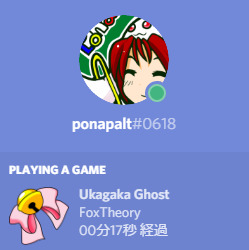
This plugin is designed for displaying the name of the primary ghost you have open on the ‘currently playing’ status on the Discord for Windows application in real-time. also compatible with displaying your currently played song in FLUX (a music player ghost by Zi).
Wallet of Unyu
by Don
⚠️NOT A REAL CRYPTOSCAMCURRENCY⚠️
UNYU is a cryptocurrency widely circulated in the world of Ukagaka.
This wallet plugin allows you to freely deposit and withdraw UNYUcoin
anyone can freely withdraw however much UNYU they want, even if you want 500 trillion UNYU
It isn’t encrypted. Transaction history is stored in plain text format in a save file.
plugin download
CeVIO-Talker V2 Plug-in
by Ambergon
This Plug-in was initially revealed for Day 21 of the Ukagaka Advent Calendar collaborative project in 2022. using this you can have a fully voiced ghost with a realistic sounding voicebank speak to you out loud! (in English too?)
it Requires ceVIO Creative Studio and SSP 2.6.45 (or newer) to work, ceVIO is a vocal synthesizer software commonly compared to Vocaloid and UTAU that works via text-to-speech method. the primary difference between Vocaloid and ceVIO is that ceVIO is built for both TTS/speech and creating vocals for songs in music production. you can download a demo of CeVIO if you would like to try it out here.
GhostSpeaker
by apxxxxxxe like CeVIO-Talker, this Plug-in was initially revealed for Day 17 of the Ukagaka Advent Calendar collaborative project in 2023. it’s a successor to the Bouyomi-chan plug-in and utilizes a free (Japanese) text-to-speech software called VOICEVOX and COEIROINK so that your ghost can verbalize their balloon dialogue and speak to you. you can listen to a demo in this github link.
GhostWardrobe
by apxxxxxxe dress-up is available by default on some ghosts but this also allows you to dress up your ghost (if compatible?) in different outfit coordinates, mix and match pieces and save and load the outfit combinations from the plugin menu.

CharameL plugin by Umeici
This plugin allows you to enjoy watching ghosts directly interact and chat amongst each other freely on a built in instant messenger. like a chatroom for seeing what your ghosts chat together about when you’re out of the room.
Stamp Collection by http://navy.nm.land.to/post/
with this plug-in you can provide links and additional information about events to the user, sort of like your ghost collecting stamps on a card when exploring each booth at a virtual convention dealer alley or an easter egg hunt.
Functions: a YAYA type plugin that notifies the user of information about a stamp. Triggered at ghost startup, plugin loading/unloading, and any set timings for OnStampInfoCall to be sent. has been used for things like providing special links and custom dialogue for Ukagaka events or the Saimoe popularity contests. it worked when I tried but a lot of the images linked in the event dialogues for existing ghosts I tried couldn’t be reached without the assistance of the Internet Archive .
compatible ghosts and the shortcuts to use for them are listed here, and new ones are still being added to that list.
if you want to incorporate it into your own ghost, refer to sample.txt.
BalloonMaker by Coderatte
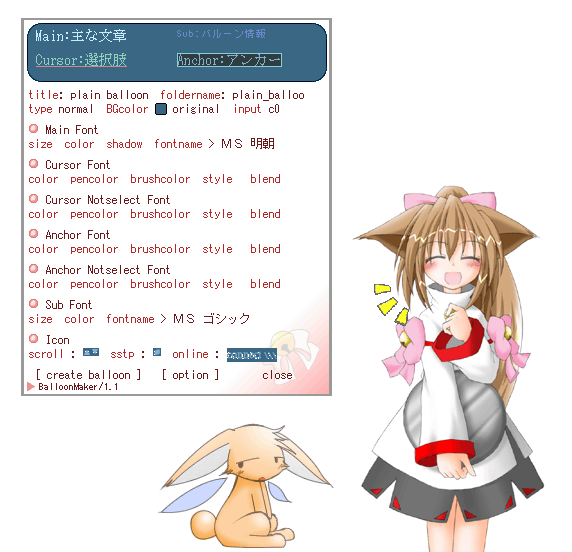
a plugin tool for creating custom balloons. balloons are the speech bubbles/text boxes you’ll see ghosts use to speak.
older plugins (that I haven’t tested succesfully yet, may have compatibility issues with current versions of SSP)
BeerShower
baton/touch plugin by Umeici
?
MicCom plugin by Umeici
?
SSTP Clients
(not plugins but refers to an external application that sends SSTP requests to the SSTP server)
Iria displays the operating process status on the dialogue balloon Kinoko
#ukagaka#ukgk#download#DL#plugin#resources#cevio#cevio ai#vocal synth#webcore#2000s internet#(these are all very modern plugins so not really but shhh i need the algorithm to cooperate#yes they work w/ old ghosts like mayura)
99 notes
·
View notes
Note
tell us more about your complicated feelings about the accuracy of shows like Bridgerton, please!!!
Thank you for asking. I've been wanting to get it out of my head.
First off, I think "historical accuracy" can be a somewhat impossible standard. We don't know the past well enough to do a one-to-one recreation, and even if we did, it would probably be kind of uninteresting. We understand that romance or mystery fiction isn't a one-to-one recreation of modern life either, even if it is set in our own time.
I hold historical accuracy to the same standards as book accuracy when it comes to adaptations. Something is going to change between mediums and that is a pretty neutral thing on the face of it. I often look for an understanding of themes (or predominant concerns of the period) and vibes more than I look for accuracy. And I let the media itself tell me how serious it wants to be about recreating the past.
I love this scene from Marie Antoinette for capturing Rococo excess, and there is a pair of Converse in it:
youtube
When I talk about shows like Bridgerton, I mean the ones that exist in this kind of "less than serious, but recognizably historical setting." Overtly self-serious works like a certain recent Napoleon movie that everyone panned are easy to critique on the grounds of historical accuracy, because they are presenting themselves as trying for that.
Bridgerton, on the other hand, is Regency with a giant asterisk. The sparkly dresses and pop song covers tell you that. I feel like it occupies a similar niche to something like Reign, where the aesthetics and the music and the story tell you it is more about romance than about serious history. You're here to have fun and watch pretty people kiss. Yet, there are recognizable historical figures in it at points, which keep it from being full fantasy.
And I don't have anything against something that is interested in being fun and romantic. My own media diet isn't exclusively serious stuff either.
The complicated part of my feelings come more from reception than anything the show is necessarily doing. To me, a historian who consumes a lot of historical media, it's pretty obvious that the show is wearing "not that historical" on its sleeve. And generally, I give that more grace because it is being clear about what it is.
However, in the wake of the show's popularity, I've seen people engaging with it in a way that gives me pause. For example, on a video of a woman making a dress for a Bridgerton premiere, a lot of people in the comments were trying to tell her to do a "period accurate" Regency dress. Period accurate. For Bridgerton. The show that takes actual Regency fashion as a suggested base that they build off of.
I've similarly seen videos along the lines of "POV a Bridgerton era girl doing [x]" that seem to be thinking Bridgerton is a representation of the time period rather than existing in its own bubble. Or people discussing it saying things like "back then [insert thing] was true" trying to draw from the actual Regency period (usually rather badly).
It's like the popularity has broken through to people who don't usually consume history or historical media, who simply miss how much the show is saying that it isn't history. It's a sort of undiscerning audience who isn't catching the blatant, intentional differences from a serious period piece because they know very little about the period. And then things merge into how they think about actual history (see also: people who bring up plot points from Reign to characterize actual Mary QoS in Mary vs Elizabeth discussions, or people who talk about "back then" with GoT or HotD)
And my complicated feeling is this: I don't actually think these shows could do more to differentiate themselves from actual history. They're giving you all the clues to say they aren't trying to do that. Yet, I can't help but think that there are still ways that they bleed into perceptions of history. And I wonder if that is an inevitability with loosely historical media.
42 notes
·
View notes
Text
Au fics that i think are neat and that i want to compile into a list because im trying to figure out how to comment on a chapter of a fic but i need time to sort out my thoughts (usually for fic recs i try to rec fics with less kudos/engagement because reasons but im just gonna throw everything in this list. probably multiple fics by the same author in the same universe because thats the one im trying to sort out my thoughts on.)
the strawberries are dying by eggowlss - historical fiction and very interesting character relationships and also character exploration within the time period. I really like this one because the pacing and tone are very gentle. There’s a srt of ebb and flow to the story that makes both the time period and the characters really fit into it. idk how to describe it i just like it a lot.
in the quiet of the night (acswy ao3 series) - they’re putting those characters in situations. It’s a very good time. 10/10 do recommend. If you haven't heard of this one though, it’s basically a modern au where everyone works at a summer camp and Mike and Will cause problems for themselves, each other, and usually everyone else around them.
si vis amari, ama by perexcri - demons and angels and heaven and hell and its honestly just one hell of a story. like ive got vivid images in my head of scenes i imagined when reading this.
you start to kiss (and the record skips) by eclipseadventure - this is a band au with a side of a secret relationship and im a sucker for secret relationships. a bit of drama/high stakes in here too which is always pretty fun.
End Racism on the OTW! - you and me and the horrible teenaged ghost who keeps eviscerating himself in our apartment makes three by TheWrongKindOfPC - i am also a sucker for buzzfeed unsolved aus. buzzfeed unsolved, hauntings, ghosts, yknow the fun stuff.
into the daylight by andiwriteordie - THIS IS NOT THE FIRST ONE, it’s just the first one that came up in my bookmarks. anyways, this is the second fic in a fantasy au series. The worldbuilding is really cool and there’s magic and history and politics and i like it a lot. the most recent chapter is spinning around in my mind.
the heartbreak prince by andiwriteordie - THIS IS THE FIRST ONE.
beneath these boughs, my devotion blooms by perexcri - this is the fic that nearly killed me. i literally cant summarize it because im still recovering from what happened to me when i read it. Did i read it in april? Maybe. Listen, it had me asking questions about things i had never considered before. its 11k but im pretty sure it took me a good few hours to read because it made me think about it so much. again, ive got a bunch of visuals running through my head. its just... so much.
sweetheart, you're so cruel by perexcri - Mike’s in a band, Will’s a music snob, they’re both contemplating their life choices. very fun, very interesting, also made me think about some things.
keep it hush by wiseatom - theres an amusement park and the horrors of customer service. and some other stuff but basically its pretty bright (the visuals of the fic in my head are bright- like sun glinting off metal- and idk how else to describe it)
the start of an age by delusionaltogether (Whyyyyy) - this ones funny and serious at times and its got Max in it. fantasy au with prince will and knight mike and a secret relationship and a small scheme between three parties that involves a fake (ish) marriage.
superhero therapy by silverluminoqity - spiderman au with a side of trauma and healing? it’s complicated theres stuff happening, i had a good time reading it.
you've got this spell on me by andiwriteordie - this one was really fun. basically its a fantasy au theres magic and mike gets himself hit with a spell that makes him fall in love with will and will freaks out about it for a while.
Daydream by disaster_energy - i really really liked this fic. its a fantasy au and its got gods and stuff and will gets chosen by the moon goddess because hes Will and everyone is like... woah.
takes one to know one by andiwriteordie - i also liked this one a lot, its a superhero au and its got ironic (like... dramatic irony- i think is what im talking about? maybe? but like fun irony) secret identities.
Love goes 'round by evil_ontheinside - conversations in a laundry mat. mikes flopping (as in, flopping around like a fish) around a bit and this was pretty cute.
my promise could be your fiend (could be the smallest of signs) by s0ld_it - spider man au, theres a bookstore involved and a lot of stuff. ive read this fic twice and greatly enjoyed it both times.
Tip-toeing on Lily-pads by cherryisgone - very very fun, fantasy au and... mike gets cursed to be a frog. can only be un-cursed with a kiss.
filling in the blanks as we go by delusionaltogether (Whyyyyy) - bookstore meetcute
there’s more but i spent all day painting my room and i am tired. Ive also got way too many bookmarks to go through and i have decided to stop here. still haven't figured out how to write that comment (but i am working on it because i love the fi(s) and ive been thinking about one specific thing that came up in a new chapter for so long). anyways, i hope someone enjoys this list of au fics from my bookmarks.
240 notes
·
View notes
Note
do you have any recommendations for books set in the UK in the 70s and 80s? I’m sure I could do research but you seem to have good taste. I’m american and want to get a read on that time for fic purposes… thank you (and no pressure if you don’t wanna reply, I feel it’s a silly question tbh but thought I’d try!)
hmm to be honest as much as im interested the period i don’t know if i’ve come across that much fiction set there!! a lot of my 70s/80s fiction seems to set in ireland instead. but on my list to read is the line of beauty by alan hollinghurst which is set in 1983 i believe? although i think it revolves around a pretty old money family so i don’t know how indicative it is of the social condition at the point…shuggie bain by douglas stuart is a scottish novel (and one of my favourite books) partially set in the 80s iirc though it ends up in the nineties..a great non-fiction read is no future by matthew worley which is an academic work charting british punk from 1976 to 1984…obviously punk and music-centric but covers a lot of the political and social situations at the time which punk and post-punk acted as a cultural response to, a sort of intense nihilism and a sense of social decline which fuelled a lot of the punk movement…honestly the music being made in the period is probably really useful for getting a feel of that sort of thing i would say!! and not just because i love it lol
that’s pretty much all i have for fiction but it’s a really fascinating time in british history and there’s so much out there..some particularly interesting bits for me (especially as someone very interested in the recent history of british trade unionism (which wielded huge power in this era compared to now)) are the miners strikes in the early 70s which led to regular powercuts + 3 day weeks and overthrew the conservative heath government, the rock against racism movement and concert in 1978 (covered in a 2019 documentary white riot) in response to the rise of the far-right white supremacist national front party in the 1970s (a bit more about this in a recent documentary called fighting the far right), the winter of discontent 78-79 under the labour callaghan government which saw widespread trade union strikes and also the coldest winter in britain for like a decade and a half…and then from 79 obviously you’ve got thatcherism and the miners strike and mass unemployment. cold war developments and euromissile crisis which saw revival of the campaign for nuclear disarmament and the greenham common women which is also a fascinating bit of history in and of itself.
pride 2014 and billy elliott are films set in this period which i love although they’re both 1984-5 and specifically about the miners strike and also very well known lol so that’s probably not that helpful. withnail and i 1987 is another great film it’s just so exquisitely bleak. sorry i could not be of more help with specific recommendations in terms of media but if there’s anything you’re interested in or u have any other questions this is kinda what i live for lol so id love to chat abt it though im purely an enthusiast and definitely not an expert!!
12 notes
·
View notes
Note
youve gotten me interested in horrible histories, could we get a lil rundown of it all? what is the idea behind it? :D
GLADLY !! I’m feel so honored that I was able to get you interested in this wonderful show :-) !! I’m assuming you’re only asking about the show BUTT you’re also gonna get an explanation about the books, Horrible Histories: Gory Games show AND the animated Horrible History characters too hehe
HORRIBLE HISTORIES 2009 SERIES:

Horrible Histories, a British sketch comedy and educational television series, first aired its 2009 season on CBBC. The show, primarily aimed at children, uses humor and parody to teach viewers about various historical events and figures. Each episode focuses on specific periods, cultures, or historical topics, presenting the information in a fun and engaging manner.
The series is based on the bestselling children's books of the same name by Terry Deary. It uses a combination of live-action sketches, animations, and musical numbers to make history more accessible and entertaining for its audience. The show's cast (Season 1 to 5), which includes Matthew Baynton, Simon Farnaby, Martha Howe-Douglas, Jim Howick, Laurence Rickard, and Ben Willbond portrays a range of historical characters, often in a comedic or exaggerated manner.
Today’s Horrible Histories (Season 6 to 10) isn’t as much as loved compared to the older Seasons, and I see why. The main reasons as to why the recent Horrible History seasons aren’t as loved is because of some controversial topics and some rewrites of history (So I recommend maybe just watching the earlier seasons).

(Just a quick note that I do not support nor condone any of the controversial topics that were written in the recent seasons, the only reason why I visit the recent episodes are to fast forward to the parts to where they show the animated clips.)
Back to the older seasons, Season 1-5 shows a great way of explaining and presenting historical topics in a fun, harmless and amusing way to its audience. There are also a bunch of British references and subtle jokes that will get a laugh out of you. The songs are quite catchy too :-D
If you are interested in watching Horrible Histories, you could always go to the BBC Horrible Histories Iplayer website or use this google drive I found on Reddit to all the episodes of Season 1-5 !!
Pros of watching Horrible Histories:
COOL FUNFACTS THAT YOU CAN FLEX TO YOUR FRIENDS THAT DON’T KNOW JACK ABOUT HISTORY !!!!!
FUN CAST I ABSOLUTELYLOVE THE SIX IDIOTS GO CHECK OUT THEIR OTHER PROJECTS
FUNNY SIDE CHARACTERS LIKE DEATH, RATTUS, SAM, CLIFF WHITELEY AND MORE !!!!!
someone kissed a priest idk
THE SONGS ??? THEY’RE THE BEST I ABSOLUTELY LOVE THEM
Cons of watching Horrible Histories:
getting the Monarchs song stuck in your head for months
sad song ending :-(
there will never be another season of horrible histories with the original cast (six idiots)
Summary: silly history show that is hosted by a talking rat with a variety of fun signs and fun other characters like Death and a historical news report guy with ADHD. also uhm a lot of people really like Matt Baynton dick turnip for some reason
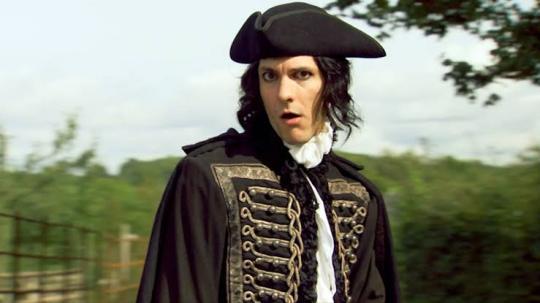
HORRIBLE HISTORIES BOOK FRANCHISE:

Horrible Histories is a series of non-fiction children's books written by Terry Deary. The books, published by Scholastic, delve into different periods of history, presenting facts in a humorous and often gory manner. The series aims to make history fun and engaging for readers by focusing on the unusual, terrible, and gruesome aspects of the past.
Each book in the series covers a specific historical era, such as the Awful Egyptians, the Measly Middle Ages, or the Terrible Tudors. The stories are told through amusing anecdotes, illustrations by Martin Brown, and timelines, often featuring shocking facts, jokes, and quirky characters. Some books also include activities, such as puzzles and quizzes, to further engage the reader.

The first titles in the series, “Terrible Tudors” and “Awesome Egyptians”, was published in 1993, and since then, the series has expanded to include more than 30 titles, covering various historical time periods and regions, like the Rotten Romans, the Vile Victorians, the Cut-Throat Celts and even gruesome guides to places you may know such as the USA, France, London and more !
The books have been translated into multiple languages and have sold millions of copies worldwide. By presenting history in this unique and irreverent manner, Horrible Histories has played a significant role in making history more appealing to readers, helping to inspire their interest and encourage further exploration.
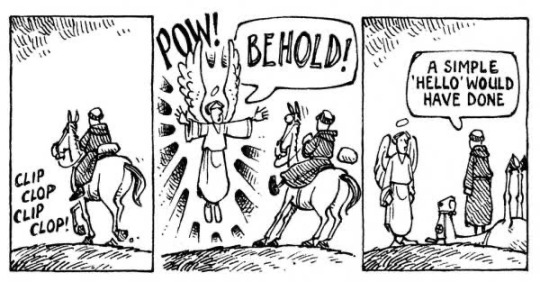
Martin Brown is an illustrator best known for his work with Terry Deary on the popular children's book franchise, Horrible Histories. He started off with illustrating greeting cards and now writes his own projects and draws illustrations for the recent Horrible History books such as “Up in the air”, “Right on Track”, Paws, Claws and Jaws”, and the upcoming new Horrible History book “The Truly Terrible History of the Toilet”.
Martin Brown’s illustrations play a significant role in the franchises' success, as they bring the gruesome and humorous aspects of history to life. His unique style combines a cartoonish aesthetic with realistic detail, creating a vivid and engaging visual experience for readers.
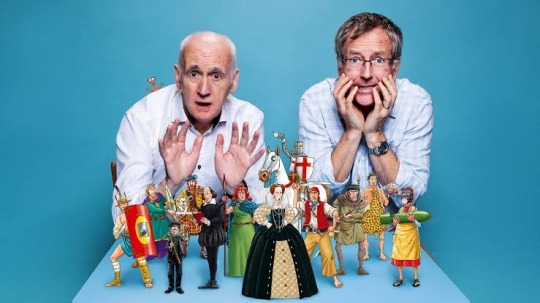
Besides reading the books, you could also play some Gruesome (not really, I just added that word for fun) Games like the Horrible Histories: The Board Game, Horrible Histories jigsaw puzzles, Horrible Histories Battle cards, Horrible Histories: Gruesome Game-A-Thons and many more !
Pros of reading Horrible History books:
FRIGHTENING FACTS !!!!!
MORE ILLUSTRATIONS !! PICTURE BOOKS 🔛🔝 !!!
dude the books are genuinely so fun theres pop up books, sicker activity books, coloring books, journals, puzzles and MORE ?????? also horrible history themed stationary stuff ANDD horrible history figurines which is like ,, well wicked.
Cons of reading horrible history books:
I haven’t ran into any cons yet so THATS A WIN FOR THE BOOKS !
Summary: READ THE BOOKS DAMN YOUR EYES !!!! god I absolutely love the books so much they’re so fun to read when ur bored and the illustrations were the reason why I even got into Horrible Histories so let’s all say “Thank you Martin Brown” I’ve learned so much from reading these books ANDDDD I spend less time on my devices woohoo !
HORRIBLE HISTORIES: GORY GAMES:
(I don’t know much about Gory Games because uhm I haven’t watched them yet I’m too busy watching Horrible Histories and the Beatles Saturday morning cartoons archived on youtube)
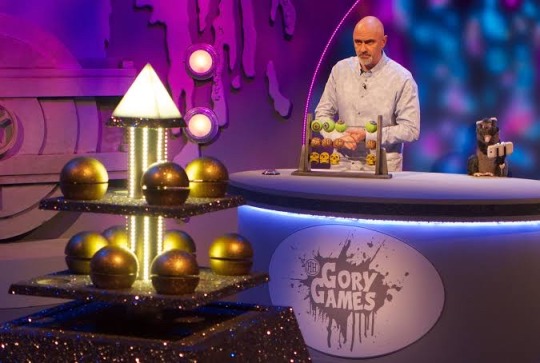
"Horrible Histories: Gory Games," a spin-off of the well-known BBC historical comedy sketch series, “Horrible Histories," is a children's game show that premiered in 2011. Created by the same team behind the original series, it's aired on CBBC. It also has a companion app for iOS and Android.
Hosted by Dave Lamb and Rattus Rattus, the show focuses on obscure historical facts. Three young contestants, known as "Horrible Historians," compete to collect "Year Spheres." These spheres represent years, either A.D. or B.C. Scoring A.D. years adds to their point total, while B.C. subtracts. The winner is determined by the contestant with the highest score after three rounds of historically-themed challenges or quizzes.
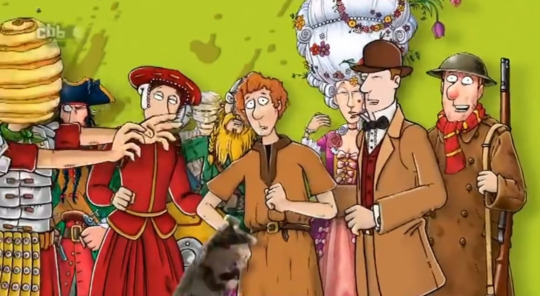
Pros of watching Horrible Histories: Gory Games:
THE ANIMATED CHARACTERS ARE THERE WHATT !! AMAZING RIGHT
You get to see Ben Willbond is a georgian costume

WATCH THE SHOW FOR YOURSELF I HAVEN’T WATCHED IT YET
Summary: if you wanna watch kids answer historical trivias then watch Horrible Histories: Gory Games (episodes can be found on youtube !!)
ANIMATED HORRIBLE HISTORY CHARACTERS:
(prepare for a long long LONGG explanation)
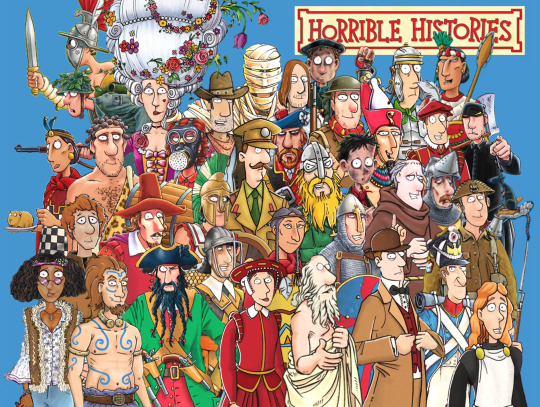
Canon/Official Information:
The reoccurring animated characters you may remember seeing in a normal Horrible Histories episode are probably the Rotten Romans soldier, Gorgeous Georgian lady, Frightful First World War british soldier or the Measly Middle Ages peasant. But do they have any background other than being a character from that era ?
[DING, DING, DING !]
These lovable but forgettable cartoon characters you’ve probably seen before make appearances in Horrible Histories: Gory Games, Horrible History book covers, Horrible History merchandise and even in the Horrible History games.
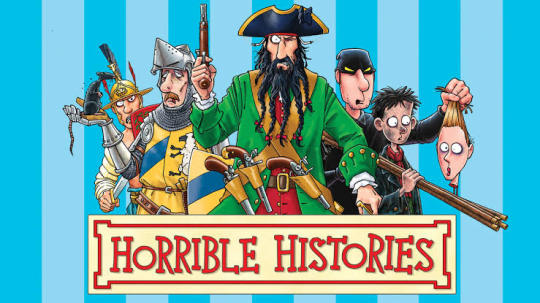
The animated/cartoon characters are used for the animated sketches or era headings in the 2009 Horrible Histories show. They also made multiple appearances in the Horrible Histories: Gory Games show, usually introducing the era topic, questions and answers. While most of the characters are recognized from the shows, almost all of them originated from the Horrible Histories book covers.
You may be surprised to hear that some characters have official names like this Victorian Gentleman, did you know his name was Howard ? Now you do.
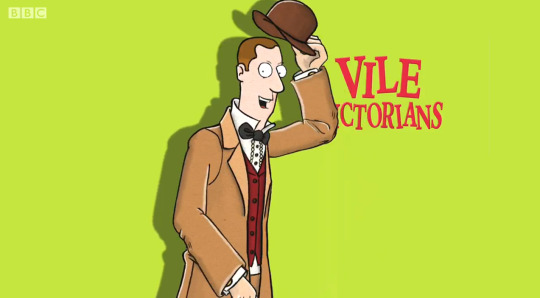
How about this Tudor lady from an animated Terrible Tudors sketch ? Her name is Alice.
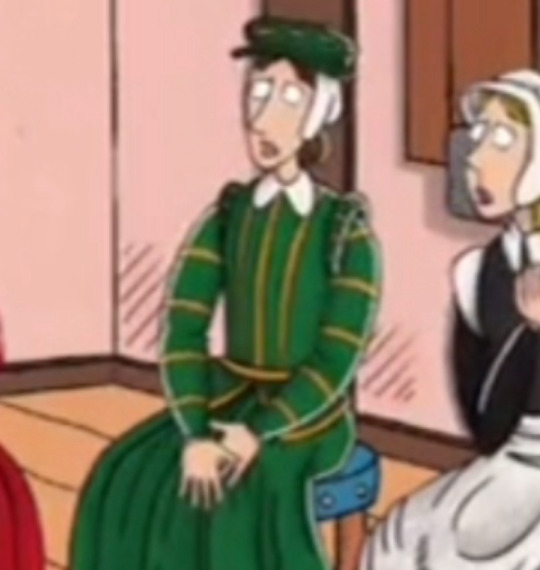
The Roundhead chief ? Oh yeah, his name is Victory.
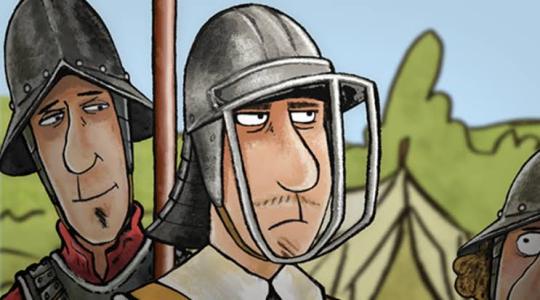
We don’t get much information/background about these little shits, but when we do it’s usually shown in a subtle or way that wouldn’t be mentioned again. So what do I do ? LIST DOWN EVERY SINGLE FACT ABOUT THEM. (Probably not every single thing about them, but a lot of facts that you may not know !)
Since my discussion about the animated characters might be a bit too long, i’ll be breaking some of the subjects I’ll be talking about into 3 topics:
Canon facts
Fanon information (Things I made up about them)
Crabby Clash (Fanon once again !)
CANON/OFFICIAL ANIMATED CHARACTER FACTS:
The animated characters can interact with non-animated characters.
The mummy giggles alot
The Vicious Viking has a daughter (Fanon name: Eirunn)
The caveman is a father of 2 boys.
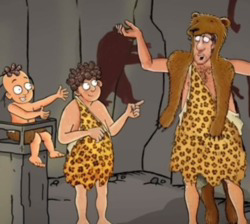
The Measly Middle Ages peasant’s family business is pig farming.
The Terrible Tudors headsman (Book cover character) does doodling
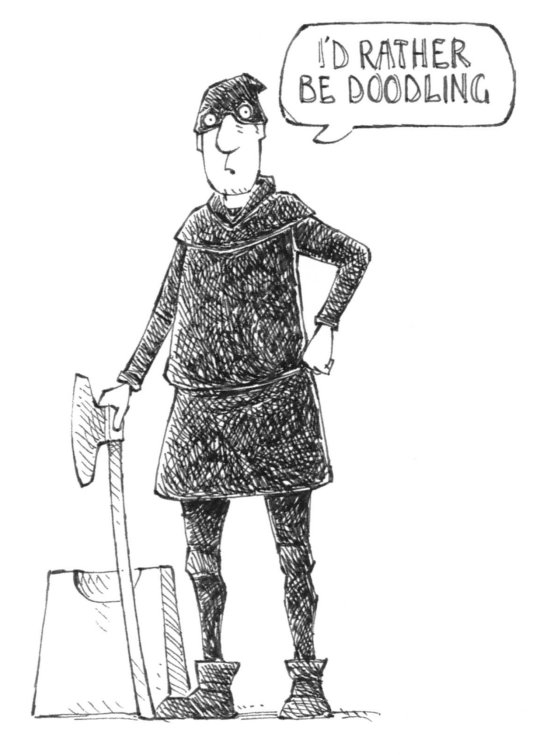
The (other) Measly Middle Ages peasant is a pilgrim.
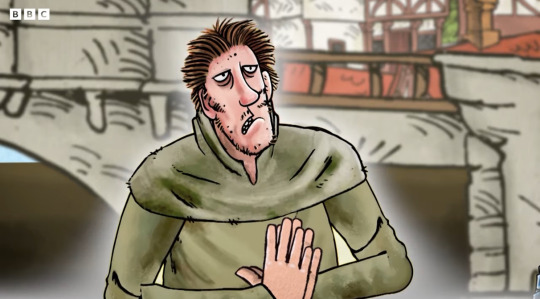
The miner minor’s (Wales book cover character) father is shown in “When I grow up”

The Viles Victorian gentleman has a wife (Name unknown).
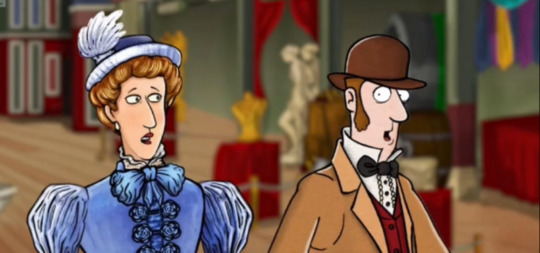
⬆️ He also sells cakes at science fairs !
The FWWI soldier has a trench mate (Shown in HH: Gruesome Game-A-Thons)

The Terrible Tudors Headsman has an official voice claim, voice actor unknown
There’s an animated HHTV News reporter named “Simon Skirmish” (Shown in “Protesting with Pankhurst” S9 EP3)
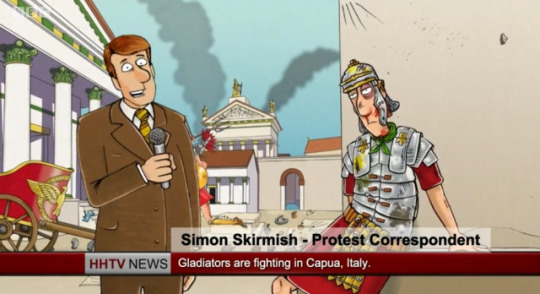
Animated Simon Cowell is canon in the animated Horrible Histories dimension
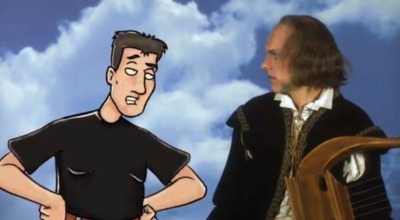
The Vile Victorian gentleman was ran over twice
I would name abunch of other facts I know, but I don’t want to make this post longer than it already is.
FANON INFORMATION:
(Note: This is just MY personal fanon opinions, other people have their own views, names and headcanons for these characters :-D)
Since BBC won’t give us more background about the animated characters, we’ll settle this the old way like any other fandom would; MAKE HEADCANONS !!!
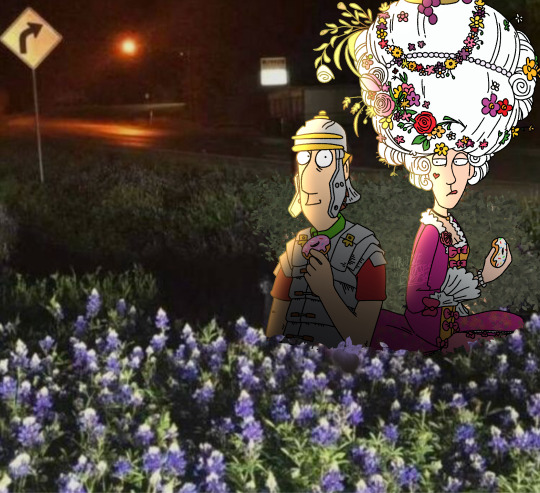
Me and a few other HH fans gave most of the characters their own backgrounds and who they are, I’m truly taken back with what their creative minds came up with. You can check some of the names I’ve given the characters with the help of a friend in this post !!
I really don’t know where to start since there are so much fanon topics I could discuss right now, but here are a 2 topics I chose to discuss for now :-)
RELATIONSHIPS:
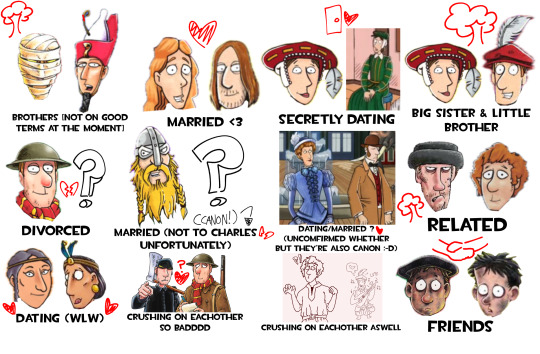
Headcanons:
(You may want to read the fanon names before reading my headcanons)
Ma-Nefer is blind (due to the fact that his pet falcon that Senouphis trained to rip his brother’s eyes out so he could become Pharaoh), his artificial eyes serve no purpose.
While Ma-Nefer was stuck at his burial, his only companion was a mummified cat he named “Geb”.
Senouphis gets a reoccurring nightmare where Ma-Nefer comes back from the dead and takes his revenge, of course that would never happen ,, yeah right.
Wycliff used to have a pet parrot, unfortunately he still hasn’t gotten over his parrot’s death.
They all hate Rattus (except for Médard aka the frenchie)
If Madeleine was ever to die during a bombing, Madeleine’s daughter would think of her doll as her mother and treat the doll as how Madeleine treated her.
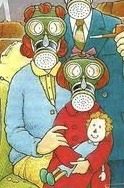
Ma-Nefer is willing to forgive Senouphis.
Egbert is unaware that he’s related to the other medieval peasant.
Archie is the troublemaker, Toby is the problem solver.
Eirunn wants to be a vicious Viking just like her father, Ragnar supports her decisions but thinks that she shouldn’t be adventuring at her age.
Chopsalot loves plum pies he would devour one in SECONDS.
Rip Chopsalot you would’ve loved raisin muffins.
Ronnie likes to write poems and record his life in the trenches.
Lady Jane despises Egbert (peasants), she will not survive 5 seconds standing near him.
Benjamin is BALDING.
My mind has gone blank at the moment, so I don’t really know what else to say but I post a lot of animated HH character stuff so if you’re willing to listen to me ramble, then make sure to stay tuned :-)
CRABBY CLASH:
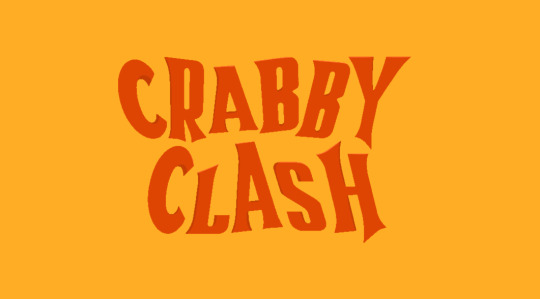
“What is ‘Crabby Clash’ anyways ?”
It’s an HHAC (Horrible Histories Animated Characters) AU where all historical periods/eras go to war against eachother, some eras/periods will have alliances while some will be on their own.
As of right now, I stil haven't figured out the alliances yet, but the whole story is completely up to you! Who wins in the Crabby Clash? Yes, that's the name of the AU (corny I know :-( ).
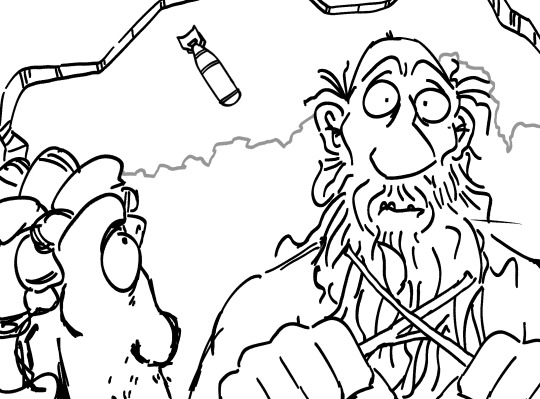
FUN FACTS about the Crabby Clash/HHAC:
The non-animated HH characters (Bob hale, Charles the II, Mike Peabody, Sue, Death, etc ..) are canon in the universe too.
A little conflict between 2 eras was the reason for the war (just like any other world war).
Women from some eras are able to go to war (because I SAY SO IT’S MY AU).
there will be yuri angst and brotherly angst so you should totally be interested in my au
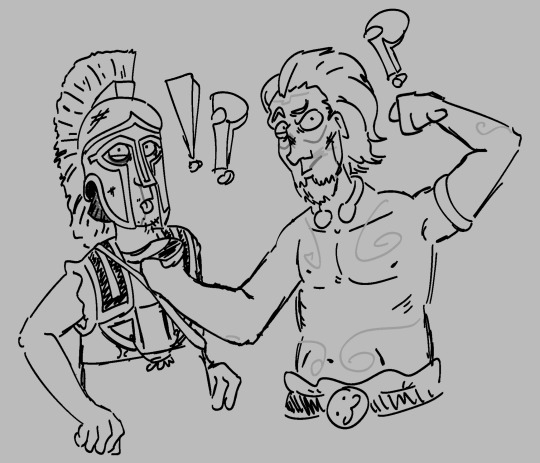
The AU is still in the making, if you’d ever like to suggest something for my AU that would be heavily appreciated <3
And that’s about it I suppose :-) thank you for coming to my ted Jimb talk and see you next Friday night folks ! walks off stage and gets swallowed by an ottoman
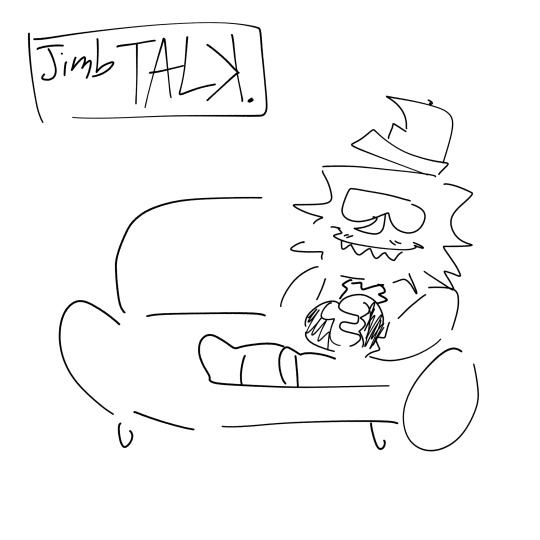
21 notes
·
View notes
Text
Deity Info: Bastet
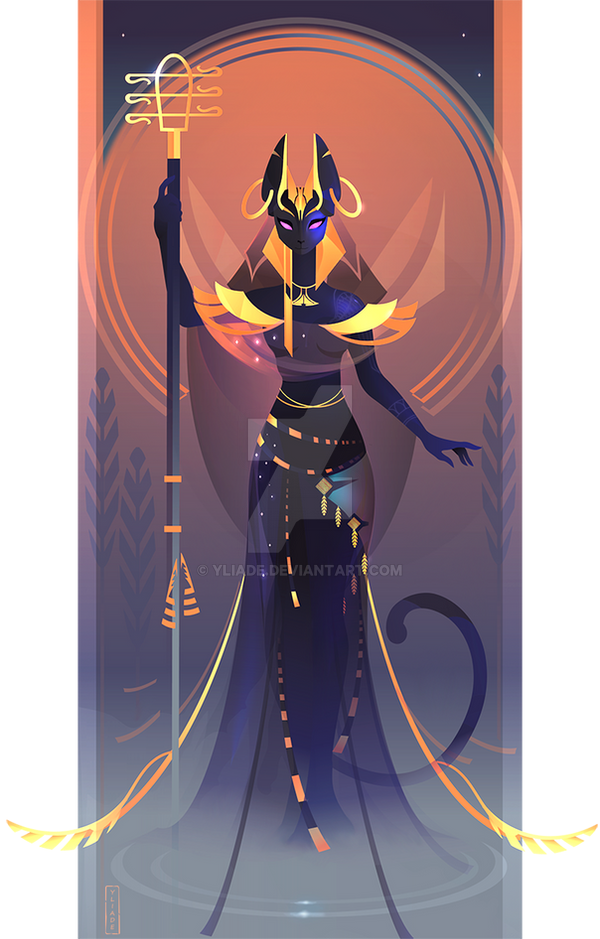
Bastet, or also known as Bast, Ubasti, and Ailuros (her Greek name), is the Egyptian goddess of: Protection, Perfume, Pleasure, Joy, Music, Dance, Home, Cats, Ointments, Women's Secrets, Domesticity, Childbirth, Sensuality, Sexuality, Good Health, and associations with both the sun and the moon. She is the daughter of the Sun God Ra. However there is many speculation of who her mother is, many sources say that her mother is Isis: Goddess of magic, life, motherhood, protection, healing, fertility, and associations with the moon.
Now many link her with her elder sister Sekhmet: Egyptian Goddess of War, Healing, Plague, Carnage, Justice, Strength, and associations with the sun, as well as their other sister, Hathor: Egyptian Goddess of Healing, Love, Joy, Beauty, Motherhood, Fertility, Celebrations, Marriage, and Association of the Sun.
In modern traditions, there are multiple ways to praise Bastet, Sekhmet, and Hathor as the most common is viewed as a goddess trio or an individual goddess. I however, worship them separately as they each have their own depictions, ideologies, and personalities. Thus why this is an individual post. I do not work or worship Hathor, however I recently came into contact with Sekhmet as most Bastet devotees eventually work with Sekhmet in a way and thus Sekhmet shall get her own post eventually.
my relationship was Bastet is a fond one as she was my first goddess I answered to and she is truly a multi-purpose goddess. She is great for if you need a goddess to help with your protections, she is great for if you need a maternal deity figure, and she is great as a goddess of joy and mirth. I typically see her as a goddess of all three just as she is intended to be. anytime I go clubbing, I always ensure that I am honoring Bastet as dancing and drinking is a very common way to honor her. I will get more into ways to honor her in a bit.
A common myth Bastet is associated with is when Set took control of Egypt and usurped the throne from Osiris and gouged out Horus's eyes. In one version of the story, Bastet is said to have fought Set and managed to retrieve one of his missing eyes for him. Another common myth is that Bastet, along with the Eyes of Ra, battles the devouring worm and defends Ra on his nightly journey on the river of night. Now I cannot say the name of the devouring worm as names have power and I swore to Bastet I would never speak his name however, I will spell it for you. A.P.O.P.H.I.S. or as he is also known as A.P.E.P.
a little fun fact about Bastet is that she was the patron of firefighters of ancient Egypt. The Egyptians believed throwing a cat into a burning fire was a way to draw out the flames. Although, I don't know how as I wasn't there in that time period however, I do find it interesting how she is the goddess of firefighters and yet my family has a long history of being firefighters.
It is unknown if Bastet is married however, she does have two known consorts. Ptah: God of Architecture and Creation and Anubis: God of Funerals, Burial Rites, and Passage in the Underworld. although, I personally believe she and Anubis have something going on since her association with Oinments links her to embalming fluids and burial as well as she has a hand in the afterlife and therefore sees Anubis quite a bit.
She does have one confirmed son, Nefertem: God of Sweet Scents, Healing, Beauty, and Perfumes. A few sources state that she has a son named Maahes: The Lion Headed Egyptian God of War and Knives. although some say that he is the son of Sekhmet.
Now you are probably tired of my info dumping on my beliefs and adoration for my soul mother, so I shall here add her favored items: Herbs, stones, etc. As well as a few of her associated symbols.
Herbs associated with her are: Vervain, Cinnamon, Lavender, Jasmine, Vanilla, Catnip, Mint, Dill, Rosemary, Orange, Juniper, Chamomile, Dandelion, Kyphi, Frankincense, Myrrh, Lotus, Sandalwood, and although I am allergic to it: Hemp. Stones and Metals associated with her are: alabaster, cat’s eye, tigers eye, citrine, turquoise, black tourmaline, lapis lazuli, sunstone, moonstone, pyrite, malachite, copper, gold, onyx, jet, Colors associated with her are: blue, black, gold, silver, gray, green, yellow, red, and orange. I personally believe that she occasionally likes purple as well, although many will tell you she loves green. Symbols associated with her are: cats, eye of ra, sistrums Tarot cards associated with her are: strength, the moon, the sun, Animals associated with her are: cats Holidays associated with her are: Feast of Sekhmet and Bast (November 22nd), Festival of Bast (February 5th), Feast of Hathor (November 29th) Days of the week sacred to her: Mondays Offerings to her include: burning incense of her favorite herbs or Kyphi, fresh water, alcohol, music, dance, perfume, jewelry, gemstones, metals, meat, images of cats, aiding strays cats, images of the eye of ra, images of sistrums, anything pleasurable (whether it be sexual, simple, or sensational), chocolate, milk, honey, candles, ways to honor her: dancing, living your life joyously, bringing smiles to others, volunteering at animal shelters, keeping a secret a woman has given you, assisting cats/elderly/children/mothers in need, taking time to enjoy the things that bring you pleasure (doesn't matter what kind), taking a nap in the sunlight, sunbathing, moonbathing, cutting your nails into points and growing them to be claws, listening to music, watching the sunrise/sunset, also working on controlling your anger issues.
Signs Bast is calling to you: seeing cats (through media, real life, being drawn to them, in dreams, etc), feeling an innate desire for fun, pleasure, or sex, feeling a maternal, compassionate, protective presence nearby, seeing her in the astral realms. Epithets: Lady of East, Sacred Eye of Ra, All Seeing Eye of Ra, Beautiful Sistrum Player, She of The Ointment Jar, Bringer of Good Health, Banisher of Negativity, Hostess of Per-Bast, Mother of Cats, Protector of Homes, Goddess of Pleasure, Daughter of The Rising Sun
I hope you found this post to be really sweet as she is. I love Bastet as she is a goddess I shall worship for my entirety of life as she multipurposes are very good for whatever stage of life you are in. As I stated, she is my soul mother, and I cannot wait for her to assist me through my journey to the hereafter. I hope I honor her well with this post as I have found this knowledge throughout the past few years.
12 notes
·
View notes